Potential Corrosivity of Untreated Groundwater in Louisiana
Links
- Document: Report (40.9 MB pdf) , HTML , XML
- Data Releases:
- USGS Data Release - Potential corrosivity scores of untreated groundwater in Louisiana
- USGS NWIS Data Release - USGS Water Data for the Nation
- NGMDB Index Page: National Geologic Map Database Index Page (html)
- Download citation as: RIS | Dublin Core
Abstract
Corrosive groundwater can cause lead, copper, and other metals to leach from pipes and plumbing fixtures in water distribution systems. Metals, if ingested, could lead to serious health implications to the nearly 2.9 million people in Louisiana who obtain their drinking water from groundwater sources. Four indices—the Langelier Saturation Index (LSI), Ryznar Stability Index (RSI), Puckorius Scaling Index (PSI), and the Potential to Promote Galvanic Corrosion (PPGC)—in addition to an analysis which normalized the results from the existing indices, the Combined Index (CI), were used to assess the corrosivity of groundwater in Louisiana and identify areas within eight major aquifers and aquifer systems with moderate to high corrosivity potential. The purpose of this study is to provide State and local governments, public water system managers, and the nearly 500,000 private well owners in Louisiana with information needed to manage drinking-water supplies and mitigate potential health risks related to leaching of metals from water pipes and fixtures.
The average scores of untreated groundwater samples from approximately 375 wells by index are as follows: LSI, −1.28; RSI, 9.78; PSI, 9.34; and CI, 4.14. The PPGC does not produce a numerical score, but the total percentage of class counts can be used to assign a classification; overall, samples in Louisiana were classified as significant concern. The percentages of groundwater samples from wells classified as potentially corrosive, by index, are as follows: LSI, 53 percent; RSI, 94 percent; PSI, 81 percent; PPGC, 98 percent; and CI, 81 percent. The percentages of samples classified as indeterminate, by index, are as follows: LSI, 46 percent; RSI, 5 percent; PSI, 12 percent; PPGC, 0 percent; and CI, 18 percent.
Introduction
Corrosive water refers to water that has certain physiochemical properties that establish the potential for it to react with and dissolve materials it contacts. Corrosive water itself is not dangerous but, if untreated, it has the potential to react with and dissolve lead, copper, and other metals from pipes, plumbing, and other existing infrastructure in water distribution systems (Swistock and others, 2009).
A national study which assessed the occurrence of potentially corrosive untreated groundwater on a statewide basis was conducted in 2016 (Belitz and others, 2016a, b, c). This study is based on methodology used in the national study but focuses only on the State of Louisiana and provides data by parish and by aquifer or aquifer system. Data related to this study are available in the associated data release (Robinson, 2024).
In Louisiana, public water-supply facilities are monitored by the Louisiana Department of Health’s Safe Drinking Water Program, which ensures compliance with State and Federal standards. Public-supply facilities are required to treat their water to meet drinking-water regulations, avoiding or reducing corrosion, metal contamination, and other undesirable water-quality issues (Louisiana Department of Health, 2020). Although the drinking water provided after treatment is regulated, ensuring that it meets the appropriate standards, systems with aging infrastructure are more susceptible to circumstances which could lead to contamination. In their 2017 review of Louisiana’s drinking-water infrastructure, the American Society of Civil Engineers found that 58 percent of the water distribution systems in Louisiana were more than 60 years old (Louisiana Section of the American Society of Civil Engineers, 2017).
Self-supplied water from private wells is not regulated by any Federal or State agency and often is not treated, which is a cause for concern if the groundwater is potentially corrosive. Statewide, about 490,000 people, or 10.5 percent of Louisiana’s total population, rely on water from privately owned domestic wells (U.S. Census Bureau, 2016). It is assumed that little or no surface water was used for rural-domestic purposes in Louisiana because suitable groundwater that generally requires minimal treatment is available (Collier and Sargent, 2018). In 2015, groundwater was withdrawn from each of Louisiana’s 13 major aquifers and aquifer systems in every parish in the State for domestic use (figs. 1–2, table 1). In addition, public-supply facilities in Louisiana provided water from groundwater sources to about 2.4 million people or 51.1 percent of the State’s total population (Collier and Sargent, 2018). In total, about 2.9 million people, or 61.6 percent of Louisiana’s population, rely on water from a groundwater source.
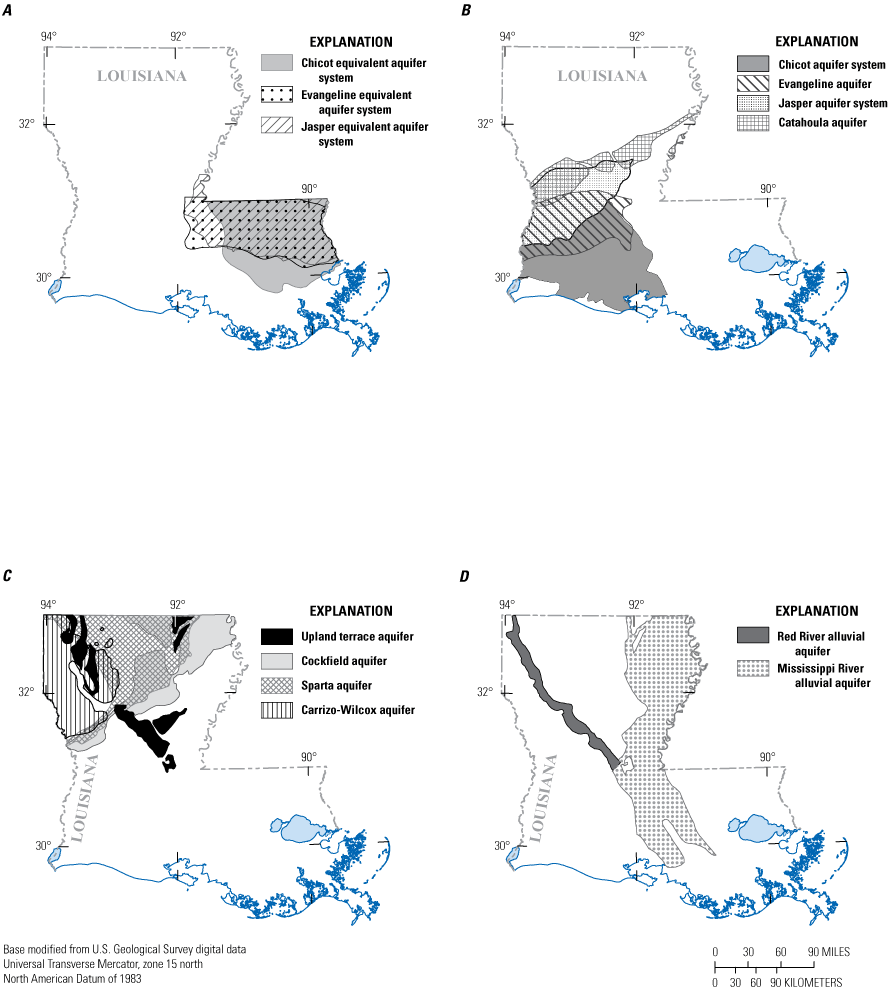
Approximate areal extent of Louisiana’s freshwater aquifers and aquifer systems, by region: A, southeastern (Jasper, Evangeline, and Chicot equivalent aquifer systems); B, central and southwestern (Catahoula and Evangeline aquifers and Jasper and Chicot aquifer systems); C, northern (upland terrace, Sparta, Carrizo-Wilcox, and Cockfield aquifers); and D, the Mississippi River and Red River alluvial aquifers (modified from Stuart and others, 1994; Collier and Sargent, 20184).
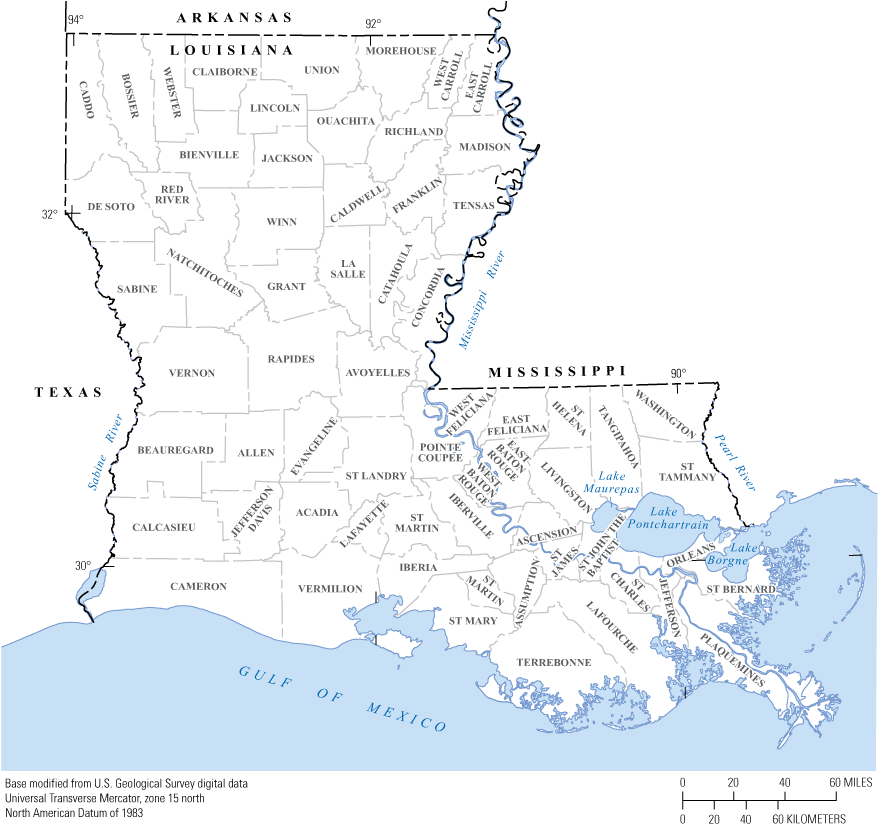
Parishes in Louisiana.
Table 1.
General characteristics of the eight major aquifer and aquifer systems that had groundwater-quality samples for corrosivity analysis for Louisiana (Stuart and others, 1994).[ft bls, feet below land surface; CSMR, chloride-to-sulfate mass ratio]
| Aquifer (fig. 1) |
Age | Average depth of wells (ft bls)1 | Primary composition | Aquifer homogeneity | Quality of water2 | Recharge | Registered domestic wells3 | |
|---|---|---|---|---|---|---|---|---|
| Number | Average depth (ft bls) | |||||||
| Carrizo-Wilcox aquifer | Eocene | 213 | Fine to medium sand, silt, clay, and lignite | Sand and gravels within the Carrizo and Wilcox aquifers are hydraulically connected and are considered to be a single aquifer (Ryals, 1984). | Soft | Direct infiltration of rainfall in subcrop and outcrop areas on northwestern edge and leakage from overlying aquifers (McGee and Brantly, 2015) | 8,109 | 200 |
| Chicot aquifer system | Pleistocene | 150 | Medium to coarse sand and gravel, grades downward to very coarse (Nyman, 1989) | Upper and lower sand units | Generally softer in northern extent, hard to very hard in south | Primarily from precipitation into sandy soil in northern portion of aquifer | 20,987 | 177 |
| Chicot equivalent aquifer system | Pleistocene | 359 | Fine sand to coarse sand and gravel | Composed of 9 local aquifers (Griffith, 2003) | Generally soft, low dissolved solids and CSMR. Harder water found in southwestern portions (Tomaszewski, 1992). | Primarily from precipitation in northern portion of aquifer system, from Mississippi-Louisiana State line (Nyman, 1989) | 13,460 | 343 |
| Evangeline equivalent aquifer system | Pliocene | 1,342 | Fine to medium sand | Composed of 11 local aquifers (Griffith, 2003) | Soft, high pH | Northern portion of aquifer system, from Mississippi-Louisiana State line | 1,911 | 714 |
| Jasper equivalent aquifer system | Miocene | 1,934 | Fine to coarse sand | Composed of 7 local aquifers (Griffith, 2003) | Soft, low CSMR | Very little in Louisiana | 131 | 1,773 |
| Mississippi River alluvial aquifer | Pleistocene | 107 | Clay, sand, and gravel (grades downward) (Tomaszewski, 2003) | Hydraulically connected to the Mississippi River (Tomaszewski, 2003) | Very hard, high alkalinity and dissolved solids (Whitfield, 1975) | Infiltration of rainfall across entire aquifer | 4,169 | 112 |
| Sparta aquifer | Eocene | 445 | Very fine to medium sand, clay, and lignite | Generally soft, low in dissolved solids. Harder water found in some western portions (Tomaszewski, 1992). | Direct infiltration of rainfall in subcrop and outcrop areas on northwestern edge and leakage from alluvium and adjacent aquifers (McGee and Brantly, 2015) | 1,717 | 241 | |
| Upland terrace aquifer | Pleistocene | 106 | Clay, silt, and fine sand grading to coarse sand and gravel at bottom (Snider and Sanford, 1981) | Soft, low alkalinity and pH | Primarily infiltration of rainfall across entire aquifer | 18,366 | 138 | |
Hardness ranges, expressed as milligrams per liter of calcium carbonate, are as follows: 0–60, soft; 61–120, moderately hard; 121–180, hard; greater than 180, very hard (Hem, 1985).
Active wells only as of October 2020 (Louisiana Department of Natural Resources, 2020).
The corrosivity of water is one of many factors that can affect the occurrence of lead, copper, and other metals in household water supplies (U.S. Environmental Protection Agency, 2016). Several different indices have been developed to measure the corrosivity of water (Singley and others, 1984; Roberge, 2007). The results presented in this report are based on four indices—the Langelier Saturation Index (LSI), Ryznar Stability Index (RSI), Puckorius Scaling Index (PSI), and the Potential to Promote Galvanic Corrosion (PPGC). These indices were selected because they are commonly used, consistent, and adaptable to large datasets. Additionally, the Combined Index (CI), which normalizes the results from the existing indices, was used in this study.
Purpose and Scope
Because groundwater is an important source of drinking water, an assessment of the potential corrosivity of untreated groundwater in Louisiana was performed by the U.S. Geological Survey (USGS), in cooperation with the Louisiana Department of Transportation and Development. The purpose of this report is to present information and summaries about the distribution of untreated, potentially corrosive, groundwater in Louisiana using four common indices—the LSI, RSI, PSI, and PPGC—and the CI.
Methods Used in the Assessment
To assess the corrosivity of groundwater in Louisiana, the LSI, RSI, PSI, and PPGC corrosion indices were calculated for all approved groundwater samples from wells which had the necessary water-quality measurements in the State (table 2). The data are based on groundwater samples collected from 374 wells from 1991 to 2018 which were queried in and downloaded from the USGS National Water Information System (NWIS) (U.S. Geological Survey, 2016).
Corrosion Indices
Even though they are referred to as “corrosion” indices, the indices used in this study do not provide a direct measure of corrosivity. Three of the four indices (the LSI, RSI, and PSI) are indicators of the saturation level of calcium carbonate (CaCO3) in a water sample. If the water is oversaturated, CaCO3 is more likely to precipitate and deposit in pipe interiors, serving as a “protective coating.” If the water is undersaturated, CaCO3 will not precipitate and may dissolve, exposing pipes and other infrastructure, which may contain lead, copper, and other metals, to potentially corrosive water (Belitz and others, 2016a). The fourth indicator, the PPGC, relates the chloride-to-sulfate mass ratio (CSMR) and alkalinity of the water to assess the potential for galvanic corrosion, an electrochemical process that can cause disintegration between two or more dissimilar metals present in a water distribution system (for example, copper or lead pipe with a component made from a dissimilar metal) (Nguyen and others, 2011).
The four indices chosen for this assessment are discussed below in chronological order of development, followed by a discussion of the CI used in this study. Other indices considered for this study but ultimately excluded are discussed in appendix 1.
Langelier Saturation Index
The LSI was developed in 1936 and is still the most popular index used to estimate the corrosive potential of water (Langelier, 1936; Langland and Dugas, 1996). Langelier (1936) stated that a negative LSI score indicates that CaCO3 is undersaturated, that CaCO3 is unlikely to form, and that corrosion is more likely to occur. As the LSI score decreases, the water is thought to become increasingly corrosive. A positive LSI score indicates that CaCO3 is oversaturated, suggesting that precipitation of CaCO3, which would limit corrosion of pipes due to scaling, is more likely to occur as the LSI score increases. An LSI score of zero indicates that the water sample is in equilibrium, with neither scaling nor corrosion likely to occur.
A simplified version of the original LSI equation was presented in Roberge (2007) and was used in this study. The LSI was calculated by subtracting the pH of calcite saturation, pHs, from the actual pH of the water:
whereA
= ;
B
= −13.12 × log10 (°C + 273) + 34.55;
C
= log10[Ca2+ as CaCO3] – 0.4; and
D
= log10[alkalinity as CaCO3].
Calcium hardness (milligrams per liter as CaCO3) is calculated from the calcium concentration (milligrams per liter as Ca2+) by using the following equation (Spellman, 2017):
An LSI score of less than –0.5 is classified as potentially corrosive, a score greater than or equal to –0.5 and less than or equal to 0.5 is indeterminate, and a score greater than 0.5 is classified as scale forming. Parishes and aquifers were assigned a classification based on the average LSI score for groundwater samples from wells within their respective bounds.
Ryznar Stability Index
The RSI, a modified version of the LSI, was published in 1944. Parameters required to calculate the RSI are the same as those needed for the LSI: pH, alkalinity (milligrams per liter as CaCO3), calcium hardness, TDS (milligrams per liter), and water temperature (degrees Celsius) (Ryznar, 1944).
wherepHs
= the pH of water that is at saturation of calcite or CaCO3 (see eq. 2).
An RSI score of less than 6 is classified as likely to scale; a score equal to or greater than 6 and less than 7 is classified as indeterminate; and a score equal to or greater than 7 is classified as having the potential for corrosion. Parishes and aquifers were assigned a classification based on the average RSI score for groundwater samples from wells within their respective bounds.
Puckorius Scaling Index
The PSI, also known as the Practical Scaling Index, was developed in 1991 as an updated version of the RSI (Puckorius and Brooke, 1991). The calculation for PSI requires values for alkalinity (milligrams per liter as CaCO3), TDS (milligrams per liter), calcium hardness (milligrams per liter as CaCO3), and water temperature (degrees Celsius).
wherepHs
= the pH at saturation in calcite or CaCO3 (see eq. 2);
pHeq
= 1.465 × log10(alkalinity) + 4.54; and
alkalinity
= .
The PSI follows the same classification scoring as the RSI. A score of less than 6 was considered likely to scale; a score equal to or greater than 6 and less than 7 was indeterminate; and a score equal to or greater than 7 was considered to have potential for corrosion. Parishes and aquifers were assigned a classification based on the average PSI score for groundwater samples from wells within their respective bounds.
Potential to Promote Galvanic Corrosion
The PPGC index was developed in 2010 by Caroline Nguyen, Kendall Stone, and Marc Edwards (2011). The calculation for PPGC requires values for chloride (milligrams per liter), sulfate (milligrams per liter), and alkalinity (milligrams per liter as CaCO3).
Water with an elevated CSMR could have higher potential for galvanic corrosion, particularly if the water’s alkalinity is low (Nguyen and others, 2011). The PPGC has three classifications:
-
1. No concern—CSMR is less than 0.2;
-
2. Significant concern—CSMR is greater than or equal to 0.2 but less than or equal to 0.5; or CSMR is greater than 0.5 and alkalinity is greater than or equal to 50 milligrams per liter (mg/L) as CaCO3; and
-
3. Serious concern—CSMR is greater than 0.5, and alkalinity is less than 50 mg/L as CaCO3.
Combined Index
A classification for each well, aquifer, and parish was established based on a combination of the four indices used in this assessment. The LSI, RSI, PSI, and PPGC were used to classify groundwater samples from each well into one of three categories, indicating the potential for water to cause corrosion. The CI normalized each of the LSI, RSI, and PSI scores on a scale of 1 to 5, increasing the number of possible categories from three to five and breaking the “scale” and “corrosion” potentials into two classes, each with room to indicate a level of severity. Due to the nature of its calculations, the PPGC could not be broken into further levels of severity; therefore, its three categories (no concern, significant concern, and serious concern) were assigned respective normalized CI scores of 1.5, 4, and 5.
To calculate the CI, the normalized scores for each index (1–5 for LSI, RSI, and PSI and 1.5, 4–5 for PPGC) were added together and then divided by the number of indices to obtain the average. The CI is always positive and ranges from 1 to 5. The five classes are (1) high potential for scale if the CI score is less than or equal to 1.50; (2) potential for scale, if the score is greater than 1.50 but less than or equal to 2.50; (3) indeterminate, meaning not more likely to scale than to corrode, if the score is greater than 2.50 but less than or equal to 3.50; (4) potentially corrosive, if the score is greater than 3.50 but less than or equal to 4.50; and (5) high potential for corrosion, if the score is greater than 4.50 (fig. 3).
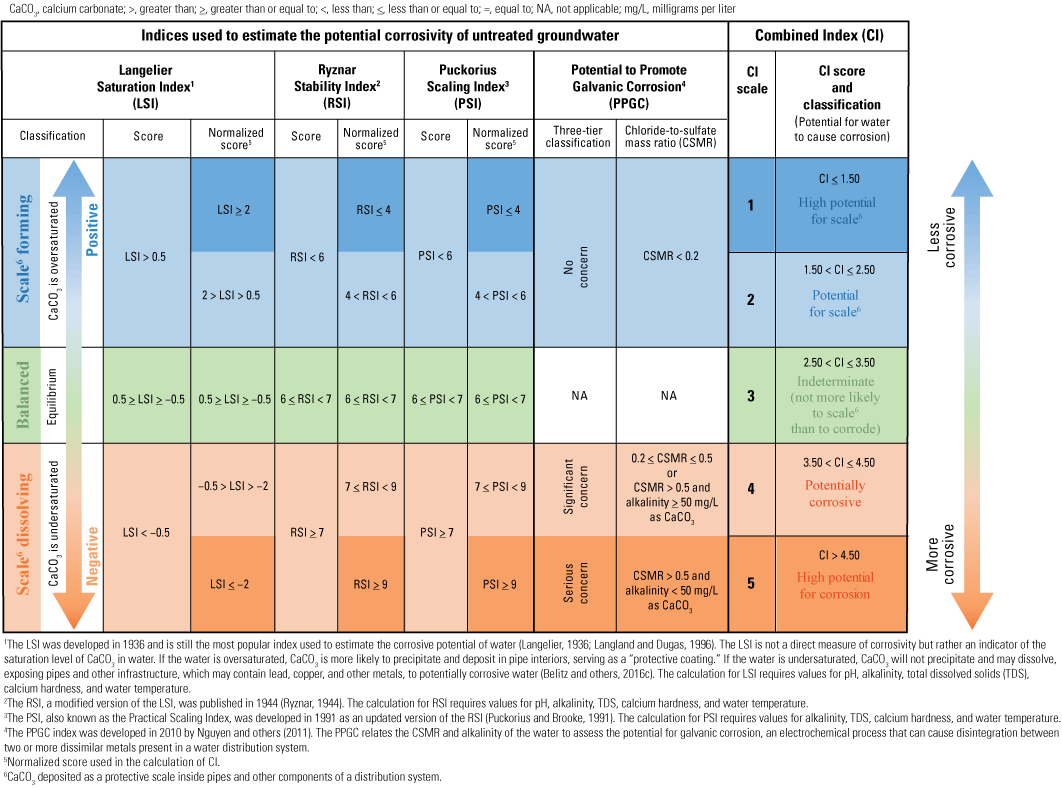
Categories of the four corrosivity indices and the Combined Index used to calculate potential corrosivity of untreated groundwater in Louisiana.
Water-Quality Data Compilation
The groundwater wells used in this study primarily included domestic and public-supply wells, but also included other types such as monitoring, irrigation, industrial, livestock, and observation wells. The water-quality data for these wells were obtained from NWIS (U.S. Geological Survey, 2016). The most recently approved record with the necessary water-quality measurements (table 2), collected from 1991 to September 2018, was used. All samples were collected before the water was treated, per USGS standards (U.S. Geological Survey, 2006), to characterize the water quality of the aquifer. This method also allows replication of the conditions of domestic well water, which is often consumed without any type of treatment. Alkalinity, calcium, chloride, pH, sulfate, and TDS were used to calculate the indices in this report (figs. 4, 5). If multiple alkalinity values were available for a well, a single value was chosen on the basis of availability in the following order: NWIS parameter codes 39086, 39036, 29802, 29801, and 00419 (the field alkalinities are preferred). Similarly, if multiple pH values were available, field values (00400) were chosen over laboratory (00403) values. In records without an approved TDS value, TDS was estimated by multiplying specific conductance (00095 or 90095) by a factor of 0.69 (Hem, 1985) (table 2).
Table 2.
Chemical constituents and NWIS parameter codes used in computations of the corrosivity indices for Louisiana.[Parameter codes are defined in the U.S. Geological Survey National Water Information System (NWIS; https://doi.org/10.5066/F7P55KJN, U.S. Geological Survey, 2016). LSI, Langelier Saturation Index; RSI, Ryznar Stability Index; PSI, Puckorius Scaling Index; PPGC, Potential to Promote Galvanic Corrosion; mg/L CaCO3, milligrams per liter as calcium carbonate; mg/L, milligrams per liter; µS/cm at 25 °C, microsiemens per centimeter at 25 degrees Celsius; std units, standard units]
When no value was available for total dissolved solids, specific conductance was multiplied by 0.69 to serve as an estimate (Hem, 1985).
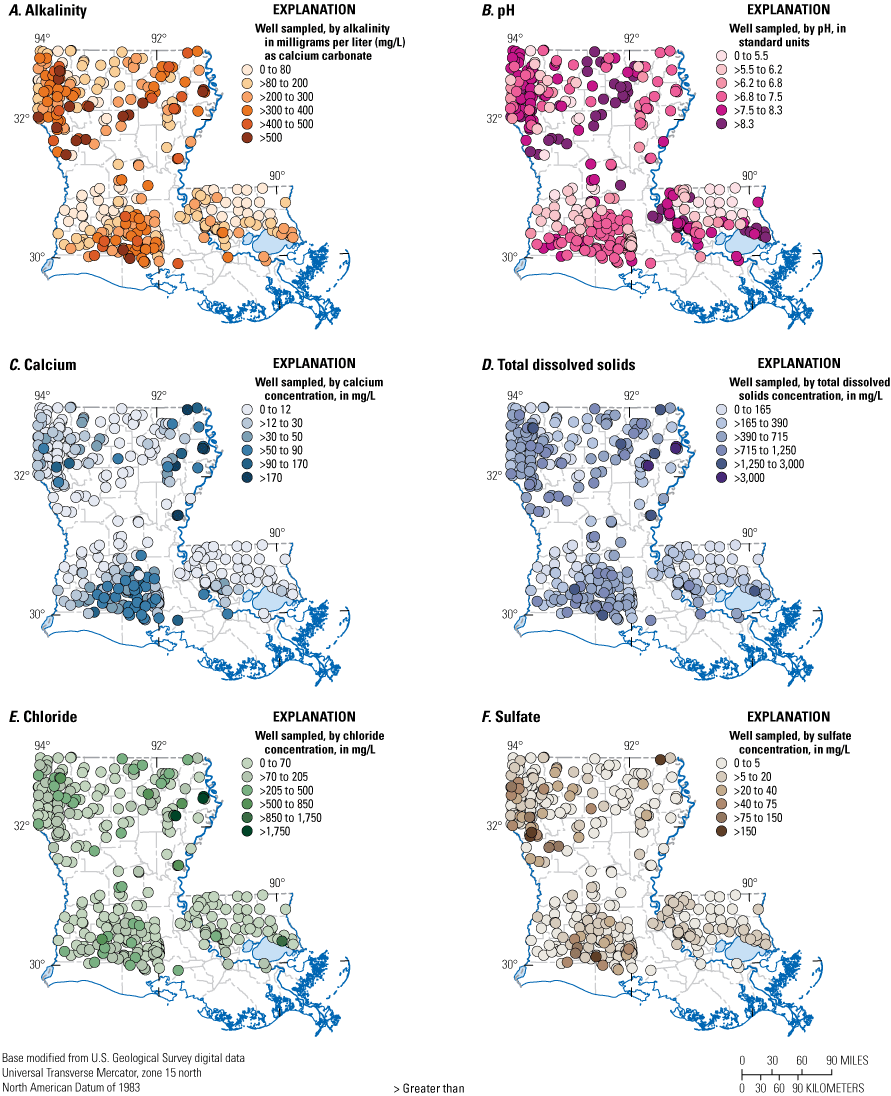
Values of the six water-quality parameters for groundwater samples from selected wells used to calculate potential corrosivity of untreated groundwater in Louisiana: A, alkalinity, B, pH, C, calcium, D, total dissolved solids, E, chloride, and F, sulfate.
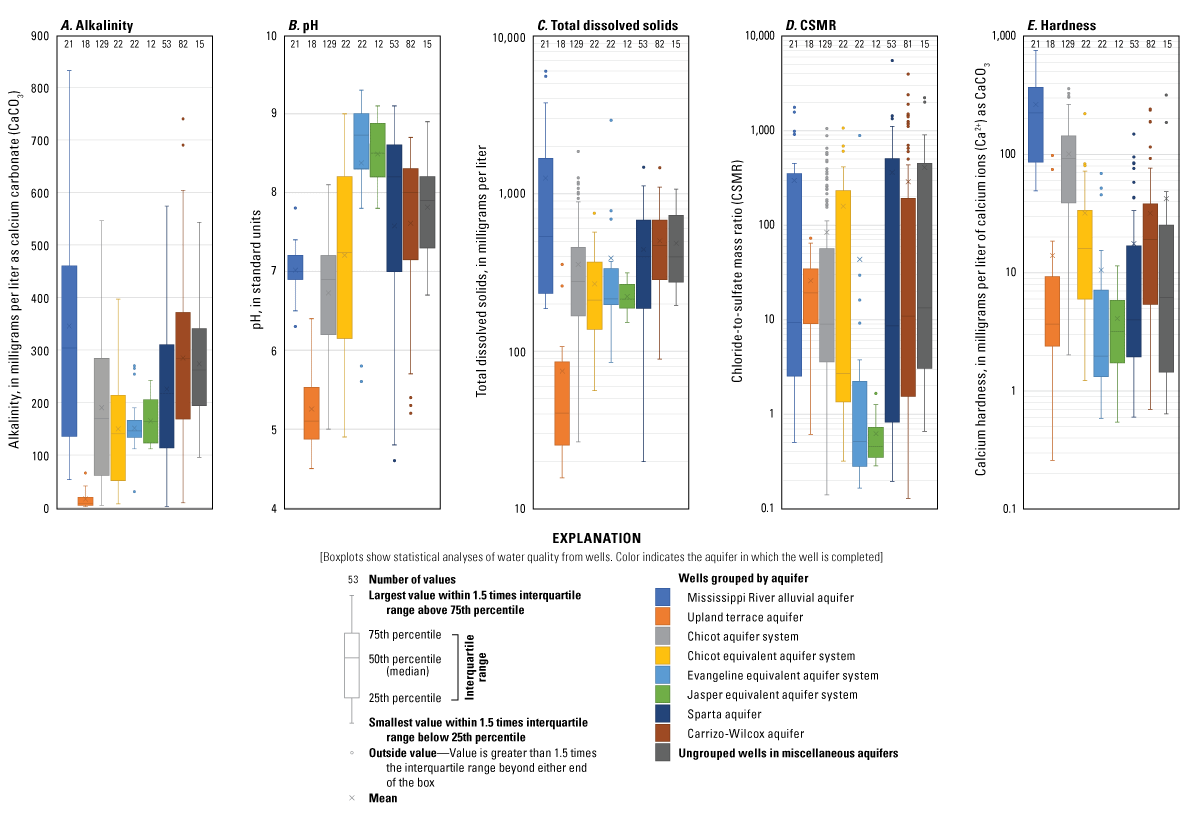
Values for the water-quality parameters A, alkalinity, B, pH, C, total dissolved solids, D, chloride-to-sulfate mass ratio, and E, hardness by aquifer or aquifer system in Louisiana. Values obtained from the U.S. Geological Survey National Water Information System (NWIS), https://waterdata.usgs.gov/nwis (U.S. Geological Survey, 2016).
The use of water-quality records from additional agencies was considered but ultimately decided against. Records from other agencies may have been analyzed by using methods other than the ones used for this study; therefore, those records would not be suitable for inclusion in this study.
Estimation of Self-Supplied Population Dependent on Groundwater
Rural-domestic, or self-supplied, population data were compiled from multiple sources. Parish population estimates for 2015 were from the U.S. Census Bureau (2016), and rural-domestic populations for each parish were based on the U.S. Census Bureau’s American Housing Survey (U.S. Census Bureau, 1993), which reported estimates of populations served by a public-supply facility. These sources, along with survey population data obtained directly from public-supply facilities, were used to estimate the population reliant on domestic wells (table 3).
Table 3.
Summary of the population dependent on self-supplied groundwater, the number of wells available for calculating the Langelier Saturation Index (LSI), Ryznar Stability Index (RSI), Puckorius Stability Index (PSI), Potential to Promote Galvanic Corrosion (PPGC), and Combined Index (CI), and the average score and classification of parish-level prevalence of potentially corrosive groundwater for the 52 parishes in Louisiana with sufficient data.[NA, not applicable; T, tie]
| Parish name (fig. 2) |
Population dependent on domestic wells | Number of wells with complete records | Average score | Classification | ||||||||
|---|---|---|---|---|---|---|---|---|---|---|---|---|
| LSI, RSI, PSI, CI | PPGC | LSI | RSI | PSI | CI | LSI | RSI | PSI | PPGC | CI | ||
| Acadia | 15,548 | 16 | 16 | −0.121 | 7.42 | 6.43 | 3.48 | Indeterminate | Potentially corrosive | Indeterminate | Significant concern | Indeterminate |
| Allen | 3,181 | 11 | 11 | −2.75 | 11.9 | 11.3 | 4.68 | Potentially corrosive | Potentially corrosive | Potentially corrosive | Significant concern | High potential for corrosion |
| Ascension | 33,565 | 2 | 2 | −0.031 | 8.16 | 8.49 | 3.87 | Indeterminate | Potentially corrosive | Potentially corrosive | Significant concern | Potentially corrosive |
| Assumption | 369 | NA | ||||||||||
| Avoyelles | 2,262 | 1 | 1 | 0.267 | 8.37 | 9.02 | 4.00 | Indeterminate | Potentially corrosive | Potentially corrosive | Significant concern | Potentially corrosive |
| Beauregard | 10,103 | 9 | 9 | −3.51 | 12.9 | 12.1 | 4.97 | Potentially corrosive | Potentially corrosive | Potentially corrosive | Serious concern | High potential for corrosion |
| Bienville | 4,068 | 9 | 9 | −2.51 | 11.67 | 11.1 | 4.39 | Potentially corrosive | Potentially corrosive | Potentially corrosive | Significant concern | Potentially corrosive |
| Bossier | 13,833 | 19 | 19 | −1.39 | 9.98 | 9.46 | 4.10 | Potentially corrosive | Potentially corrosive | Potentially corrosive | Significant concern | Potentially corrosive |
| Caddo | 18,379 | 32 | 32 | −1.11 | 9.62 | 9.25 | 4.17 | Potentially corrosive | Potentially corrosive | Potentially corrosive | Significant concern | Potentially corrosive |
| Calcasieu | 24,567 | 11 | 11 | −0.484 | 8.38 | 8.04 | 3.91 | Indeterminate | Potentially corrosive | Potentially corrosive | Significant concern | Potentially corrosive |
| Caldwell | 756 | 2 | 2 | −0.608 | 9.72 | 9.65 | 4.37 | Potentially corrosive | Potentially corrosive | Potentially corrosive | Significant concern | Potentially corrosive |
| Cameron | 918 | 2 | 2 | 0.0898 | 7.22 | 6.38 | 3.37 | Indeterminate | Potentially corrosive | Indeterminate | Significant concern | Indeterminate |
| Catahoula | 1,262 | 1 | 1 | −3.35 | 13.4 | 12.5 | 4.75 | Potentially corrosive | Potentially corrosive | Potentially corrosive | Significant concern | High potential for corrosion |
| Claiborne | 2,063 | 2 | 2 | −1.74 | 11.4 | 11.7 | 4.63 | Potentially corrosive | Potentially corrosive | Potentially corrosive | Significant concern | High potential for corrosion |
| Concordia | 789 | 3 | 3 | −0.271 | 7.91 | 6.99 | 3.42 | Indeterminate | Potentially corrosive | Indeterminate | Significant concern | Indeterminate |
| DeSoto | 7,514 | 24 | 24 | −0.607 | 9.01 | 8.72 | 4.04 | Potentially corrosive | Potentially corrosive | Potentially corrosive | Significant concern | Potentially corrosive |
| East Baton Rouge | 2,984 | 13 | 13 | −0.657 | 9.61 | 10.2 | 4.18 | Potentially corrosive | Potentially corrosive | Potentially corrosive | Significant concern | Potentially corrosive |
| East Carroll | 182 | 1 | 1 | −0.339 | 7.58 | 6.32 | 3.50 | Indeterminate | Potentially corrosive | Indeterminate | Significant concern | Indeterminate |
| East Feliciana | 3,341 | 9 | 9 | −3.42 | 13.1 | 12.7 | 4.86 | Potentially corrosive | Potentially corrosive | Potentially corrosive | Serious concern | High potential for corrosion |
| Evangeline | 4,212 | 8 | 8 | −0.719 | 8.30 | 7.14 | 3.75 | Potentially corrosive | Potentially corrosive | Potentially corrosive | Significant concern | Potentially corrosive |
| Franklin | 7,967 | 9 | 9 | −0.287 | 7.67 | 6.76 | 3.53 | Indeterminate | Potentially corrosive | Indeterminate | Significant concern | Potentially corrosive |
| Grant | 2,758 | NA | ||||||||||
| Iberia | 13,066 | 1 | 1 | 0.0576 | 6.88 | 5.51 | 3.00 | Indeterminate | Indeterminate | Likely to scale | Significant concern | Indeterminate |
| Iberville | 1,932 | 1 | 1 | −0.411 | 7.82 | 6.86 | 3.50 | Indeterminate | Potentially corrosive | Indeterminate | Significant concern | Indeterminate |
| Jackson | 1,881 | 2 | 2 | −0.187 | 8.57 | 8.72 | 3.87 | Indeterminate | Potentially corrosive | Potentially corrosive | Significant concern | Potentially corrosive |
| Jefferson | 412 | 2 | 2 | −0.420 | 8.99 | 9.12 | 4.13 | Indeterminate | Potentially corrosive | Potentially corrosive | Significant concern | Potentially corrosive |
| Jefferson Davis | 4,815 | 15 | 15 | −0.392 | 7.84 | 6.90 | 3.60 | Indeterminate | Potentially corrosive | Indeterminate | Significant concern | Potentially corrosive |
| Lafayette | 33,218 | 37 | 37 | −1.55 | 9.62 | 8.59 | 4.25 | Potentially corrosive | Potentially corrosive | Potentially corrosive | Significant concern | Potentially corrosive |
| Lafourche | 241 | NA | ||||||||||
| LaSalle | 712 | NA | ||||||||||
| Lincoln | 2,350 | 2 | 2 | −1.23 | 10.6 | 11.0 | 4.50 | Potentially corrosive | Potentially corrosive | Potentially corrosive | Significant concern | Potentially corrosive |
| Livingston | 25,051 | 5 | 5 | −2.11 | 10.8 | 10.4 | 4.50 | Potentially corrosive | Potentially corrosive | Potentially corrosive | Significant concern | Potentially corrosive |
| Madison | 239 | 3 | 3 | 0.515 | 6.10 | 4.55 | 2.50 | Scaling potential | Indeterminate | Likely to scale | Significant concern | Potential for scale |
| Morehouse | 2,004 | 9 | 9 | −0.706 | 8.72 | 8.09 | 3.97 | Potentially corrosive | Potentially corrosive | Potentially corrosive | Significant concern | Potentially corrosive |
| Natchitoches | 6,384 | 4 | 4 | −1.52 | 10.8 | 11.0 | 4.31 | Potentially corrosive | Potentially corrosive | Potentially corrosive | Significant concern | Potentially corrosive |
| Orleans | 2,585 | NA | ||||||||||
| Ouachita | 4,788 | 9 | 9 | −0.333 | 9.17 | 9.47 | 4.14 | Indeterminate | Potentially corrosive | Potentially corrosive | Significant concern | Potentially corrosive |
| Plaquemines | 614 | NA | ||||||||||
| Pointe Coupee | 2,839 | 5 | 5 | −0.679 | 10.1 | 11.0 | 4.30 | Potentially corrosive | Potentially corrosive | Potentially corrosive | Significant concern | Potentially corrosive |
| Rapides | 5,589 | 8 | 8 | −1.87 | 11.0 | 10.8 | 4.47 | Potentially corrosive | Potentially corrosive | Potentially corrosive | Significant concern | Potentially corrosive |
| Red River | 2,510 | 2 | 2 | −1.17 | 8.83 | 7.31 | 3.75 | Potentially corrosive | Potentially corrosive | Potentially corrosive | Significant concern | Potentially corrosive |
| Richland | 5,889 | 2 | 2 | −1.22 | 9.34 | 8.58 | 4.25 | Potentially corrosive | Potentially corrosive | Potentially corrosive | Significant concern | Potentially corrosive |
| Sabine | 12,546 | 5 | 5 | −1.23 | 10.2 | 9.92 | 4.17 | Potentially corrosive | Potentially corrosive | Potentially corrosive | Significant concern | Potentially corrosive |
| St. Bernard | 119 | NA | ||||||||||
| St. Charles | 239 | NA | ||||||||||
| St. Helena | 6,531 | 3 | 3 | −5.07 | 15.4 | 14.7 | 5.00 | Potentially corrosive | Potentially corrosive | Potentially corrosive | Serious concern | High potential for corrosion |
| St. James | 176 | 1 | 1 | −0.234 | 7.27 | 5.72 | 3.25 | Indeterminate | Potentially corrosive | Likely to scale | Significant concern | Indeterminate |
| St. John the Baptist | 987 | NA | ||||||||||
| St. Landry | 8,095 | 5 | 5 | −0.707 | 8.33 | 7.38 | 3.75 | Potentially corrosive | Potentially corrosive | Potentially corrosive | Significant concern | Potentially corrosive |
| St. Martin | 10,108 | NA | ||||||||||
| St. Mary | 1,684 | NA | ||||||||||
| St. Tammany | 66,008 | 12 | 12 | −1.24 | 10.5 | 11.0 | 4.32 | Potentially corrosive | Potentially corrosive | Potentially corrosive | Significant concern | Potentially corrosive |
| Tangipahoa | 35,766 | 8 | 8 | −4.37 | 14.6 | 14.1 | 4.81 | Potentially corrosive | Potentially corrosive | Potentially corrosive | Serious concern | High potential for corrosion |
| Tensas | 232 | 1 | 1 | −0.203 | 7.41 | 6.23 | 3.50 | Indeterminate | Potentially corrosive | Indeterminate | Significant concern | Indeterminate |
| Terrebonne | 92 | NA | ||||||||||
| Union | 2,412 | 7 | 7 | −0.650 | 9.59 | 9.91 | 4.21 | Potentially corrosive | Potentially corrosive | Potentially corrosive | Significant concern | Potentially corrosive |
| Vermilion | 27,383 | 11 | 11 | −0.110 | 7.47 | 6.52 | 3.48 | Indeterminate | Potentially corrosive | Indeterminate | Significant concern | Indeterminate |
| Vernon | 15,575 | 4 | 4 | −5.54 | 16.2 | 15.9 | 5.00 | Potentially corrosive | Potentially corrosive | Potentially corrosive | Serious concern | High potential for corrosion |
| Washington | 16,979 | 2 | 2 | −4.14 | 14.8 | 14.9 | 4.75 | Potentially corrosive | Potentially corrosive | Potentially corrosive | Significant/serious concern (T) | High potential for corrosion |
| Webster | 4,512 | 7 | 7 | −1.07 | 9.43 | 9.23 | 4.16 | Potentially corrosive | Potentially corrosive | Potentially corrosive | Significant concern | Potentially corrosive |
| West Baton Rouge | 478 | 6 | 6 | −0.934 | 10.6 | 11.6 | 4.45 | Potentially corrosive | Potentially corrosive | Potentially corrosive | Significant concern | Potentially corrosive |
| West Carroll | 889 | 1 | 1 | −0.064 | 7.13 | 5.93 | 3.25 | Indeterminate | Potentially corrosive | Likely to scale | Significant concern | Indeterminate |
| West Feliciana | 513 | 4 | 4 | −1.88 | 11.0 | 10.8 | 4.62 | Potentially corrosive | Potentially corrosive | Potentially corrosive | Significant concern | High potential for corrosion |
| Winn | 2,518 | 6 | 6 | −1.33 | 10.5 | 10.4 | 4.46 | Potentially corrosive | Potentially corrosive | Potentially corrosive | Significant concern | Potentially corrosive |
| State | 491,582 | 374 | 373 | −1.28 | 9.78 | 9.34 | 4.14 | Potentially corrosive | Potentially corrosive | Potentially corrosive | Significant concern | Potentially corrosive |
Results and Discussion
Calculations of four corrosivity indices for groundwater samples from wells in Louisiana were the primary results of this study. The LSI, RSI, and PSI were calculated for 374 samples. The PPGC was calculated for only 373 samples because the chloride and sulfate values were unavailable at one well in Caddo Parish. The CI, which normalized the results from the indices to provide an overall classification of each aquifer and parish, was also calculated.
A summary page for each index was created and includes a State map with the index’s calculated score at each well, a pie chart with the distribution of samples in each classification, and a box plot with results by aquifer. In addition, a summary for the eight aquifers or aquifer systems, as well as one for wells from aquifers with fewer than ten samples, was created and provides a map of each sample’s combined index score, stacked bar charts of samples by classification and by index, and a table which lists the average score by index and parish.
Corrosion Indices
Langelier Saturation Index Scores
Statewide, the LSI classified 53 percent of the untreated groundwater samples as potentially corrosive, 46 percent as indeterminate, and 2 percent as scale forming (fig. 6). Parishwide, of the 52 parishes with sufficient data, the average LSI score of samples within 33 parishes classified as having the potential for corrosion and 18 classified as indeterminate. Madison was the only parish whose average score classified as scale forming. Groundwater samples in Vernon Parish had the lowest average score at −5.54, which indicates a strong potential for corrosion. Groundwater samples from Madison Parish had the highest average score at 0.515, indicating that it is the least likely to have corrosive water (table 3).
Seven of the eight major aquifers and aquifer systems that were sampled had an average LSI score that classified as potentially corrosive (table 4). The upland terrace aquifer had groundwater samples with the highest corrosion potential, with an average score of −4.98. The Mississippi River alluvial aquifer was the only aquifer whose samples classified as indeterminate, with an average score of −0.226. No aquifers had an average score that was classified as scale forming (fig. 7).

Langelier Saturation Index classifications for 374 wells used to calculate potential corrosivity of untreated groundwater in Louisiana.
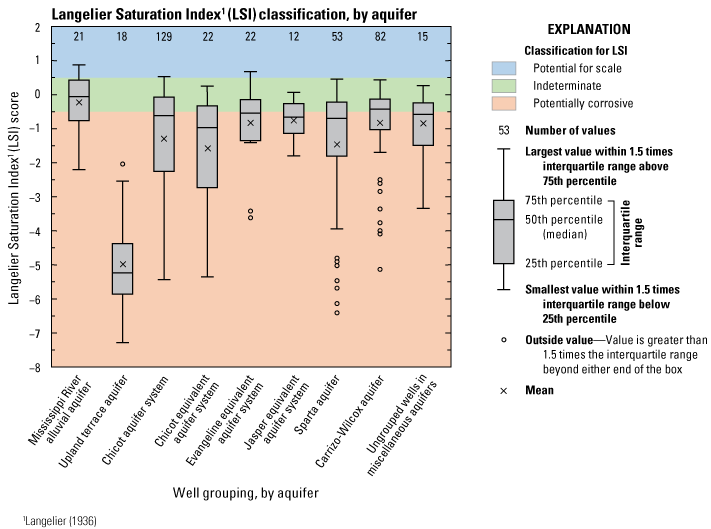
Langelier Saturation Index classifications, by aquifer, for 374 wells used to calculate potential corrosivity of untreated groundwater in Louisiana.
Table 4.
Summary of the number of wells available for calculating the Langelier Saturation Index (LSI), Ryznar Stability Index (RSI), Puckorius Stability Index (PSI), Potential to Promote Galvanic Corrosion (PPGC), and Combined Index (CI), and the average score and classification of aquifer-level prevalence of potentially corrosive groundwater for the eight aquifers or aquifer systems and ungrouped wells in Louisiana with sufficient data.| Aquifer (fig. 1) |
Number of wells with complete records | Average score | Classification | ||||||||
|---|---|---|---|---|---|---|---|---|---|---|---|
| LSI, RSI, PSI, CI | PPGC | LSI | RSI | PSI | CI | LSI | RSI | PSI | PPGC | CI | |
| Carrizo-Wilcox aquifer | 82 | 81 | −0.822 | 9.26 | 8.90 | 4.07 | Potentially corrosive | Potentially corrosive | Potentially corrosive | Significant concern | Potentially corrosive |
| Chicot aquifer system | 129 | 129 | −1.29 | 9.30 | 8.41 | 4.03 | Potentially corrosive | Potentially corrosive | Potentially corrosive | Significant concern | Potentially corrosive |
| Chicot equivalent aquifer system | 22 | 22 | −1.57 | 10.4 | 10.1 | 4.36 | Potentially corrosive | Potentially corrosive | Potentially corrosive | Significant concern | Potentially corrosive |
| Evangeline equivalent aquifer system | 22 | 22 | −0.824 | 10.1 | 10.9 | 4.27 | Potentially corrosive | Potentially corrosive | Potentially corrosive | Significant concern | Potentially corrosive |
| Jasper equivalent aquifer system | 12 | 12 | −0.761 | 10.0 | 10.7 | 4.35 | Potentially corrosive | Potentially corrosive | Potentially corrosive | Significant concern | Potentially corrosive |
| Mississippi River alluvial aquifer | 21 | 21 | −0.226 | 7.46 | 6.36 | 3.36 | Indeterminate | Potentially corrosive | Indeterminate | Significant concern | Indeterminate |
| Sparta aquifer | 53 | 53 | −1.46 | 10.5 | 10.5 | 4.33 | Potentially corrosive | Potentially corrosive | Potentially corrosive | Significant concern | Potentially corrosive |
| Upland terrace aquifer | 18 | 18 | −4.98 | 15.2 | 14.5 | 4.99 | Potentially corrosive | Potentially corrosive | Potentially corrosive | Serious concern | High potential for corrosion |
| Ungrouped wells | 15 | 15 | −0.843 | 9.49 | 9.26 | 4.12 | Potentially corrosive | Potentially corrosive | Potentially corrosive | Significant concern | Potentially corrosive |
| State | 374 | 373 | −1.28 | 9.78 | 9.34 | 4.14 | Potentially corrosive | Potentially corrosive | Potentially corrosive | Significant concern | Potentially corrosive |
Ryznar Stability Index Scores
Statewide, 94 percent of the groundwater samples were classified by the RSI as potentially corrosive, 5 percent as indeterminate, and 1 percent as potential for scale forming (fig. 8). Parishwide, of the 52 parishes with sufficient data, the average RSI score of groundwater samples within 50 parishes classified as having the potential for corrosion and two were indeterminate. Vernon Parish had the highest average RSI score at 16.2. Madison Parish had the lowest average score at 6.10, making it the least likely parish to contain corrosive water and classifying the groundwater samples in this parish as indeterminate (table 3).
All eight aquifers and aquifer systems that were sampled during this study had an average score classified by the RSI as potentially corrosive (table 4). The upland terrace aquifer had groundwater samples with the highest average RSI score by a substantial margin at 15.2, with the second highest being the samples from the Sparta aquifer at 10.5. The samples from the Mississippi River alluvial aquifer had the least corrosive groundwater, with an average score of 7.46, which is still classified as corrosive (fig. 9).
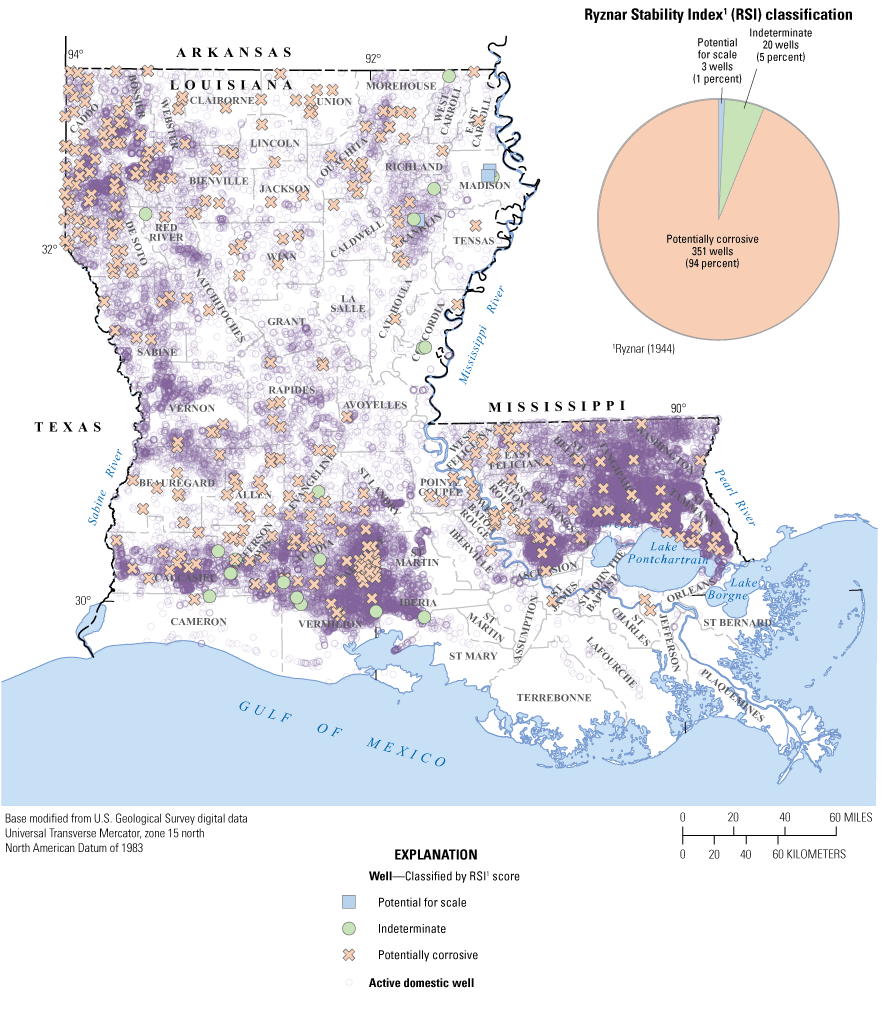
Ryznar Stability Index classifications for 374 wells used to calculate potential corrosivity of untreated groundwater in Louisiana.
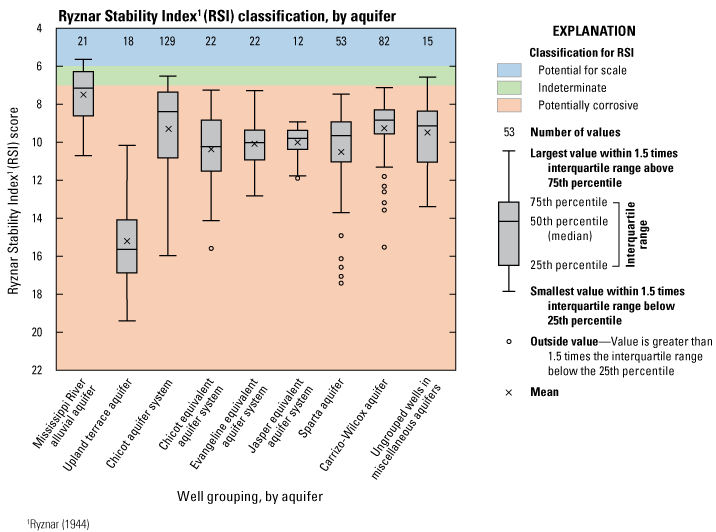
Ryznar Stability Index classifications, by aquifer, for 374 wells used to calculate potential corrosivity of untreated groundwater in Louisiana.
Puckorius Scaling Index Scores
Statewide, 81 percent of the groundwater samples were classified by the PSI as having potentially corrosive conditions, 12 percent as indeterminate, and 7 percent as scale forming (fig. 10). Parishwide, of the 52 parishes with adequate data, the average PSI score of groundwater samples within 39 parishes classified as potentially corrosive, 9 classified as indeterminate, and 4 classified as scale forming. Vernon Parish had the highest average score at 15.9, indicating that samples from the parish have potentially corrosive groundwater. Madison Parish had the lowest average score at 4.55, making it the least likely to have corrosive groundwater and classifying the groundwater samples in this parish as scale forming (table 3).
Of the eight major aquifers and aquifer systems that were sampled, seven had an average PSI score that classified as potentially corrosive and one classified as indeterminate (table 4). Samples from the upland terrace aquifer ranked as the most corrosive with an average score of 14.5, and the Mississippi River alluvial aquifer, the only aquifer whose average classified as indeterminate, was the least corrosive with an average score of 6.36 (fig. 11).
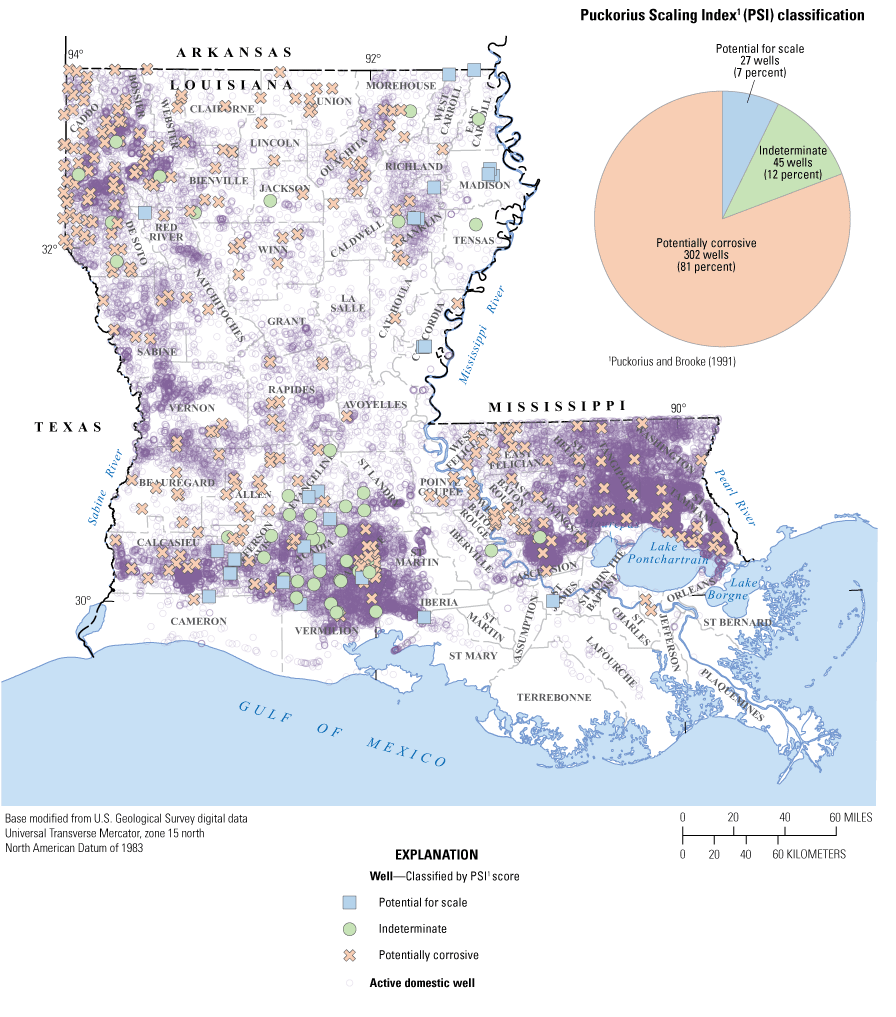
Puckorius Scaling Index classifications for 374 wells used to calculate potential corrosivity of untreated groundwater in Louisiana.
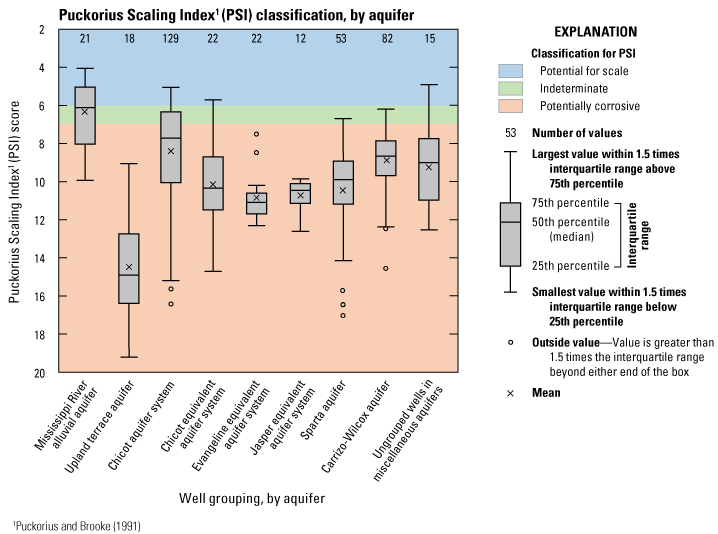
Puckorius Scaling Index classifications, by aquifer, for 374 wells used to calculate potential corrosivity of untreated groundwater in Louisiana.
Potential to Promote Galvanic Corrosion Scores
Statewide, the PPGC classified 16 percent of the groundwater samples from wells as having serious concern for corrosion, 83 percent as significant concern for corrosion, and 2 percent as having no concern for corrosion (fig. 12). Parishwide, 46 of the 52 parishes (table 3) and seven of the eight aquifers included in this analysis were classified as significant concern with respect to the highest percentage of groundwater samples from wells having each score within their respective bounds (table 4). Groundwater in five parishes and one aquifer, the upland terrace, was classified as having serious concern for corrosivity. One parish had a tie with the same number of groundwater samples which classified as having significant and serious concerns for corrosion.
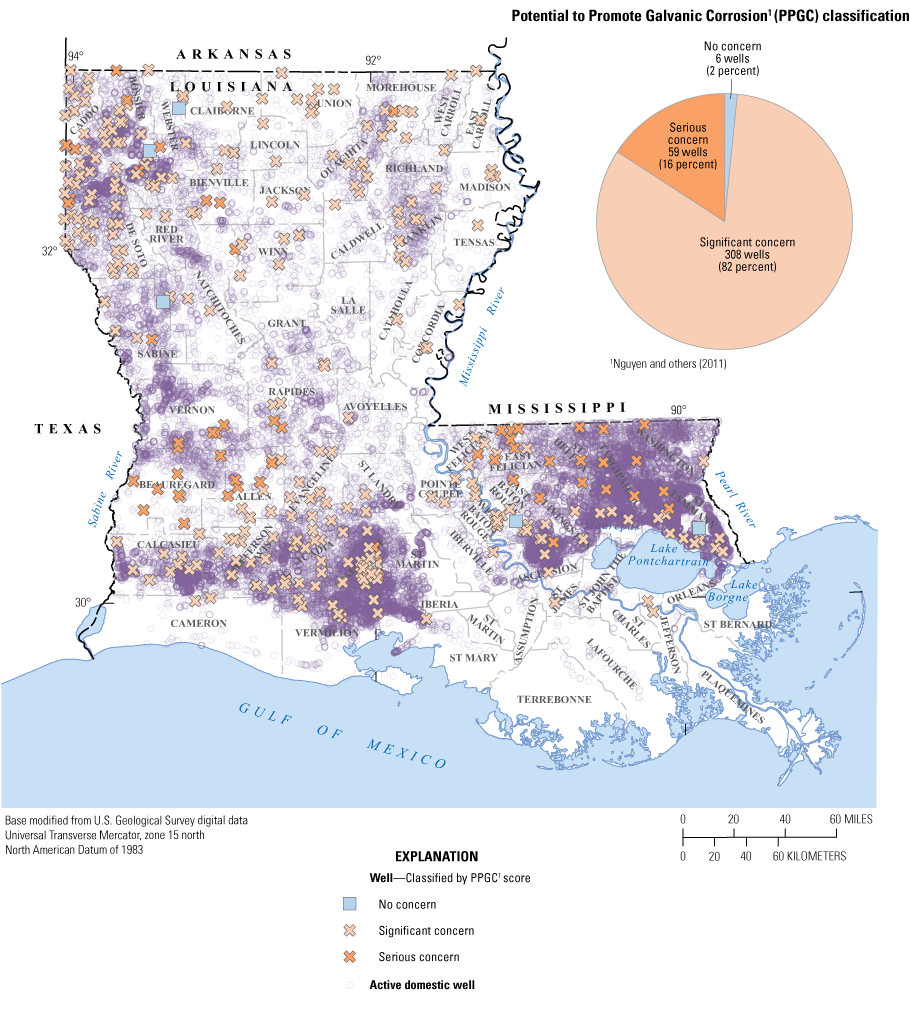
Potential to Promote Galvanic Corrosion classifications for 373 wells used to calculate potential corrosivity of untreated groundwater in Louisiana.
Combined Index Scores
Statewide, the CI classified 81 percent of the groundwater samples as potentially corrosive or having a high potential for corrosion (58 and 23 percent, respectively), 18 percent as indeterminate, and 1 percent as having potential for scale (fig. 13). Parishes and aquifers were assigned a classification based on the average CI score for untreated groundwater samples from wells within their respective bounds. Of the 52 parishes with adequate data, 10 had an average CI score which classified as having a high potential for corrosion, 31 as potentially corrosive, and 10 were classified as indeterminate. Madison Parish was the only parish whose average groundwater sample score classified as having the potential for scale. The average CI score in two parishes, St. Helena and Vernon, indicated the highest potential for corrosive water, with CI scores of 5.00, meaning they scored in the highest category for potential corrosivity in each index. Samples from Madison Parish had the lowest average score at 2.50, making it the least likely to have corrosive groundwater.
Of the eight aquifers and aquifer systems with sufficient data for this study, one had samples whose average CI score classified as having a high potential for corrosion, six classified as potentially corrosive, and one classified as indeterminate. Samples from the upland terrace aquifer had the highest average CI score at 4.99. Samples from the Mississippi River alluvial aquifer classified as indeterminate with an average score of 3.36. There were no aquifers whose average CI score classified as scale forming (fig. 14).
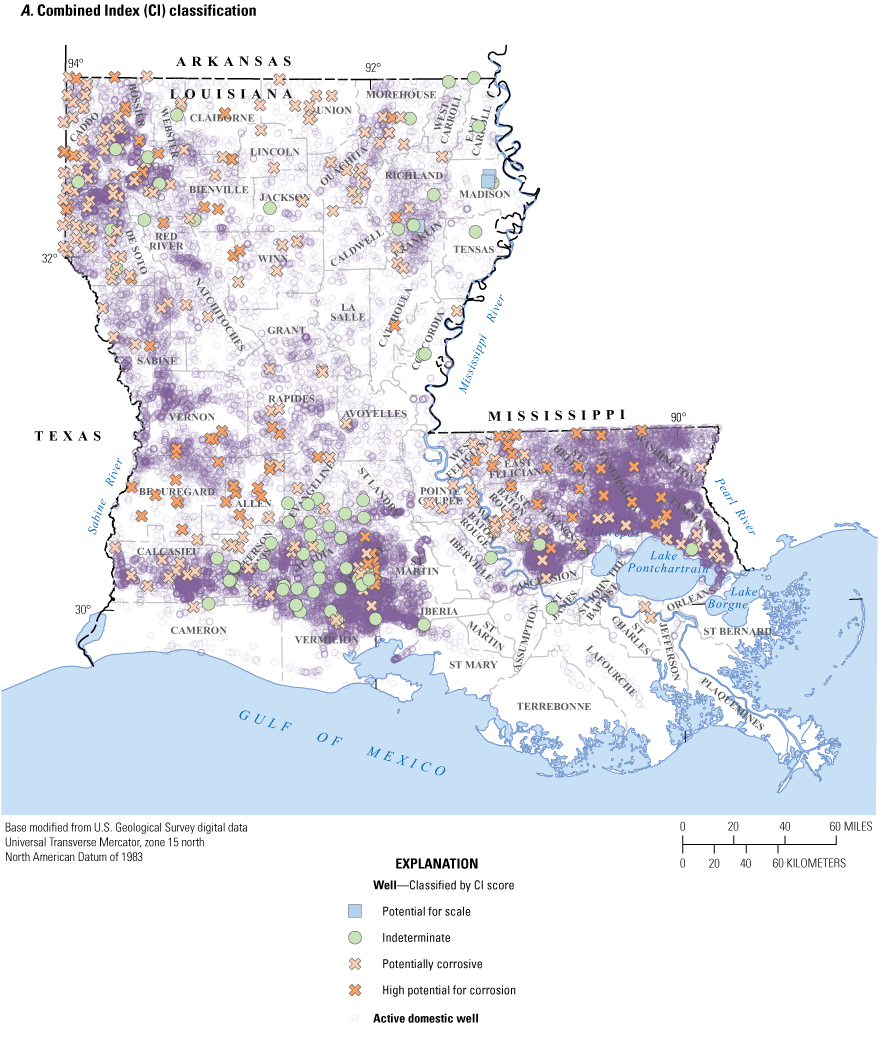
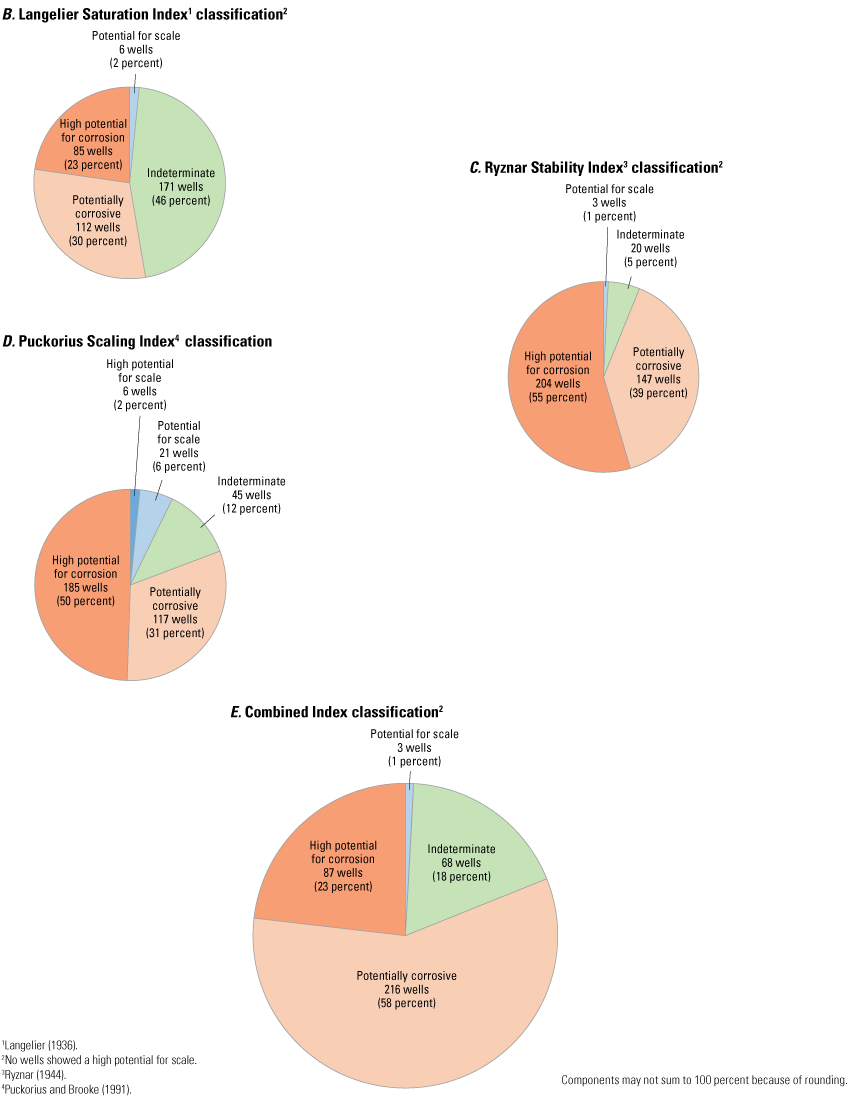
A, E, Combined Index (CI) classifications and B, Langelier Saturation Index, C, Ryznar Stability Index, and D, Puckorius Scaling Index CI-normalized classifications for 374 wells used to calculate potential corrosivity of untreated groundwater in Louisiana.
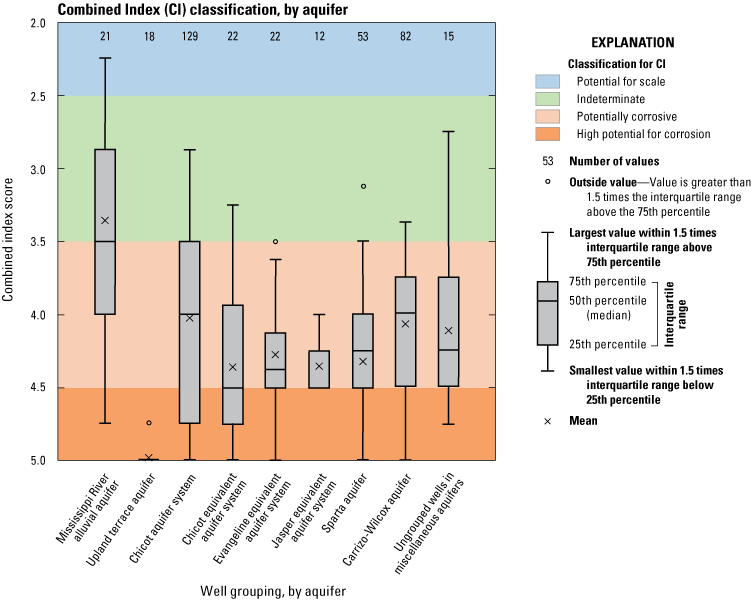
Combined Index classifications, by aquifer, for 374 wells used to calculate potential corrosivity of untreated groundwater in Louisiana.
Potential Corrosivity of Groundwater in Aquifers
Eight of Louisiana’s 13 aquifer groups had a sufficient number of samples to summarize and characterize the potential corrosivity of groundwater in the aquifers. A minimum of 10 samples was established as the threshold required to characterize the potential corrosivity of groundwater in an aquifer; therefore, the Catahoula, Cockfield, and Evangeline aquifers, the Jasper aquifer system, and the Red River alluvial aquifer were not included in this analysis because they each had fewer than 7 complete samples available (U.S. Geological Survey, 2016).
Mississippi River Alluvial Aquifer
Data associated with groundwater samples from 21 wells screened in the Mississippi River alluvial aquifer were used to calculate the LSI, RSI, PSI, CI, and PPGC scores (figs. 15–16). The average scores for the LSI, RSI, PSI, and CI, respectively, were −0.226, 7.46, 6.36, and 3.36 (table 5). The PPGC classified all 21 samples as having significant concern for corrosivity (fig. 16). Samples from the Mississippi River alluvial aquifer had the lowest scores of any aquifer or aquifer system in this study for the potential for corrosion (table 4).
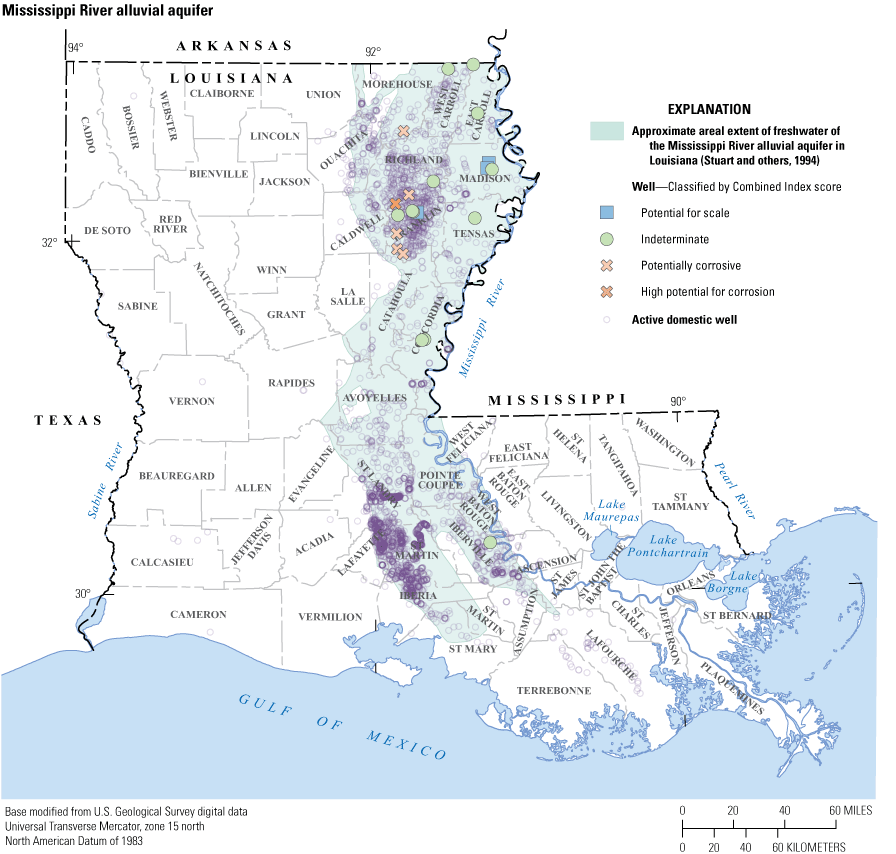
Combined Index classifications for wells used to calculate potential corrosivity of untreated groundwater in the Mississippi River alluvial aquifer in Louisiana.
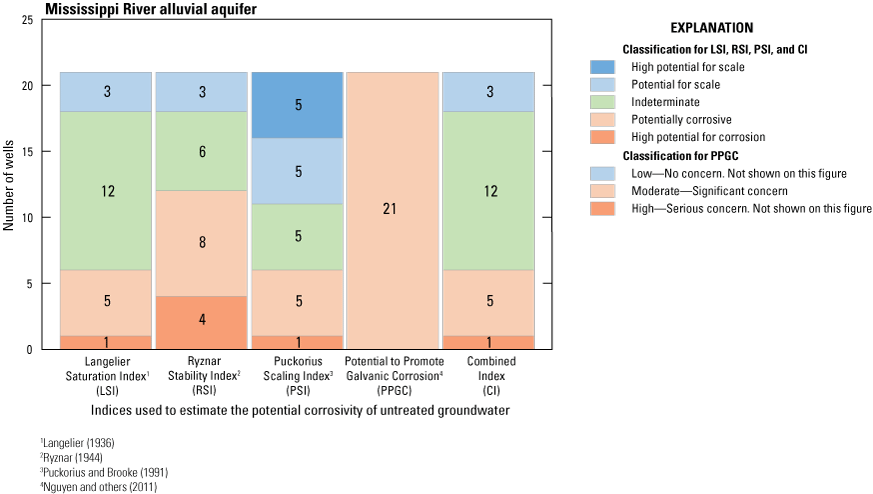
Numbers of wells in each classification of the Langelier Saturation Index, Ryznar Stability Index, Puckorius Stability Index, Potential to Promote Galvanic Corrosion, and Combined Index for calculation of potential corrosivity of groundwater in the Mississippi River alluvial aquifer in Louisiana.
Table 5.
Average potential corrosivity scores by index by parish for wells screened in the Mississippi River alluvial aquifer in Louisiana.[LSI, Langelier Saturation Index; RSI, Ryznar Stability Index; PSI, Puckorius Stability Index; PPGC, Potential to Promote Galvanic Corrosion; CI, Combined Index]
| Parish (fig. 15) | LSI | RSI | PSI | PPGC | CI |
|---|---|---|---|---|---|
| Concordia | 0.431 | 6.34 | 5.15 | Significant concern | 2.88 |
| East Carroll | −0.339 | 7.58 | 6.32 | Significant concern | 3.50 |
| Franklin | −0.287 | 7.67 | 6.76 | Significant concern | 3.53 |
| Iberville | −0.411 | 7.82 | 6.86 | Significant concern | 3.50 |
| Madison | 0.515 | 6.10 | 4.55 | Significant concern | 2.50 |
| Morehouse | −0.675 | 8.00 | 6.70 | Significant concern | 3.50 |
| Richland | −2.20 | 10.7 | 9.93 | Significant concern | 4.75 |
| Tensas | −0.203 | 7.41 | 6.23 | Significant concern | 3.50 |
| West Carroll | −0.0637 | 7.13 | 5.93 | Significant concern | 3.25 |
| Average | −0.226 | 7.46 | 6.36 | Significant concern | 3.36 |
Upland Terrace Aquifer
Data associated with groundwater samples from 18 wells screened in the upland terrace aquifer were used to calculate the LSI, RSI, PSI, CI, and PPGC scores (figs. 17–18). The average scores for the LSI, RSI, PSI, and CI, respectively, were −4.98, 15.2, 14.5, and 4.99 (table 6). The PPGC classified 17 of 18 samples (or 94 percent) in this aquifer as having a serious concern for corrosion (fig. 18). The upland terrace aquifer had the highest average scores of any aquifer or aquifer system in this study for the potential for corrosion.
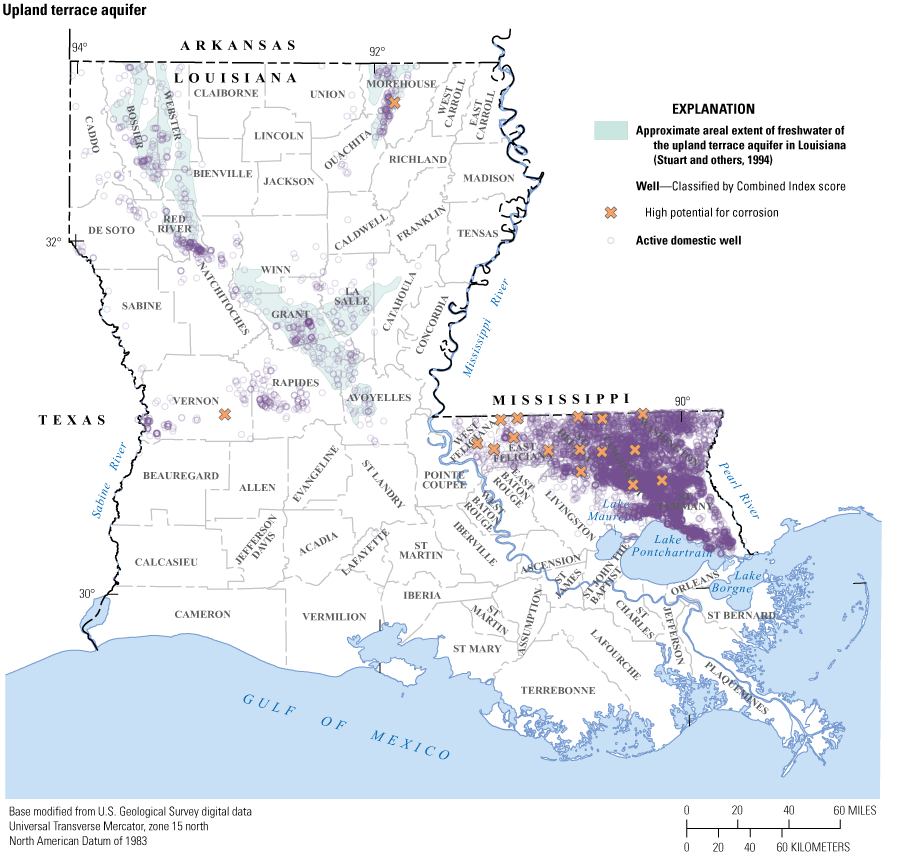
Combined Index classifications for wells used to calculate potential corrosivity of untreated groundwater in the upland terrace aquifer in Louisiana.
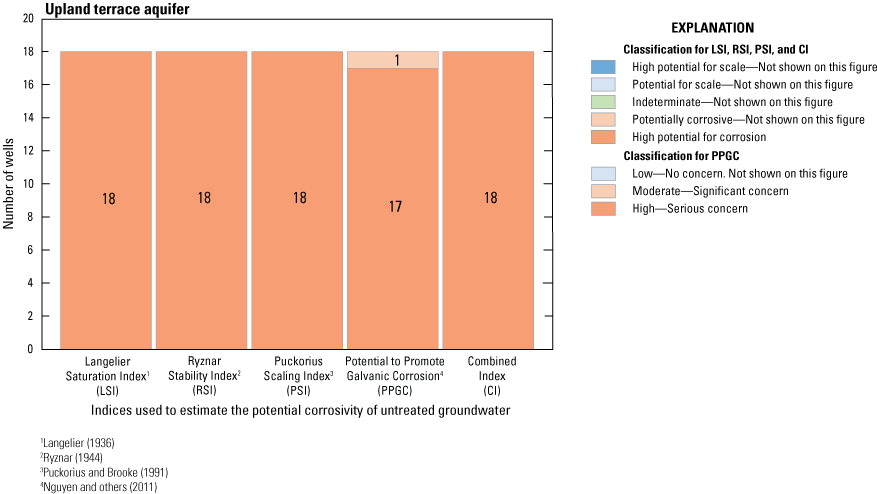
Numbers of wells in each classification of the Langelier Saturation Index, Ryznar Stability Index, Puckorius Stability Index, Potential to Promote Galvanic Corrosion, and Combined Index for calculation of potential corrosivity of groundwater in the upland terrace aquifer in Louisiana.
Table 6.
Average potential corrosivity scores by index by parish for wells screened in the upland terrace aquifer in Louisiana.[LSI, Langelier Saturation Index; RSI, Ryznar Stability Index; PSI, Puckorius Stability Index; PPGC, Potential to Promote Galvanic Corrosion; CI, Combined Index; T, tie]
| Parish (fig. 17) | LSI | RSI | PSI | PPGC | CI |
|---|---|---|---|---|---|
| East Feliciana | −4.58 | 14.6 | 14.0 | Serious concern | 5.00 |
| Morehouse | −2.29 | 10.6 | 9.53 | Significant/serious concern (T) | 4.87 |
| St. Helena | −5.07 | 15.4 | 14.7 | Serious concern | 5.00 |
| St. Tammany | −5.29 | 15.9 | 15.5 | Serious concern | 5.00 |
| Tangipahoa | −6.03 | 16.9 | 16.4 | Serious concern | 5.00 |
| Vernon | −6.39 | 17.3 | 16.5 | Serious concern | 5.00 |
| Washington | −6.49 | 17.8 | 17.3 | Serious concern | 5.00 |
| West Feliciana | −4.71 | 14.3 | 13.0 | Serious concern | 5.00 |
| Average | −4.98 | 15.2 | 14.5 | Serious concern | 4.99 |
Chicot Aquifer System
Data associated with groundwater samples from 129 wells screened in the Chicot aquifer system were used to calculate the LSI, RSI, PSI, and CI scores (figs. 19–20). The average scores for the indices, respectively, were −1.29, 9.30, 8.41, and 4.03; The PPGC classified the groundwater samples in this aquifer as having significant concern for corrosivity, with 105 of the 129 samples (or 81 percent) scoring in this class (fig. 20). Allen, Beauregard, Rapides, and Vernon Parishes, all in the northwest portion of the Chicot aquifer system (fig. 19), have the highest numbers of samples with groundwater that is potentially corrosive (table 7).
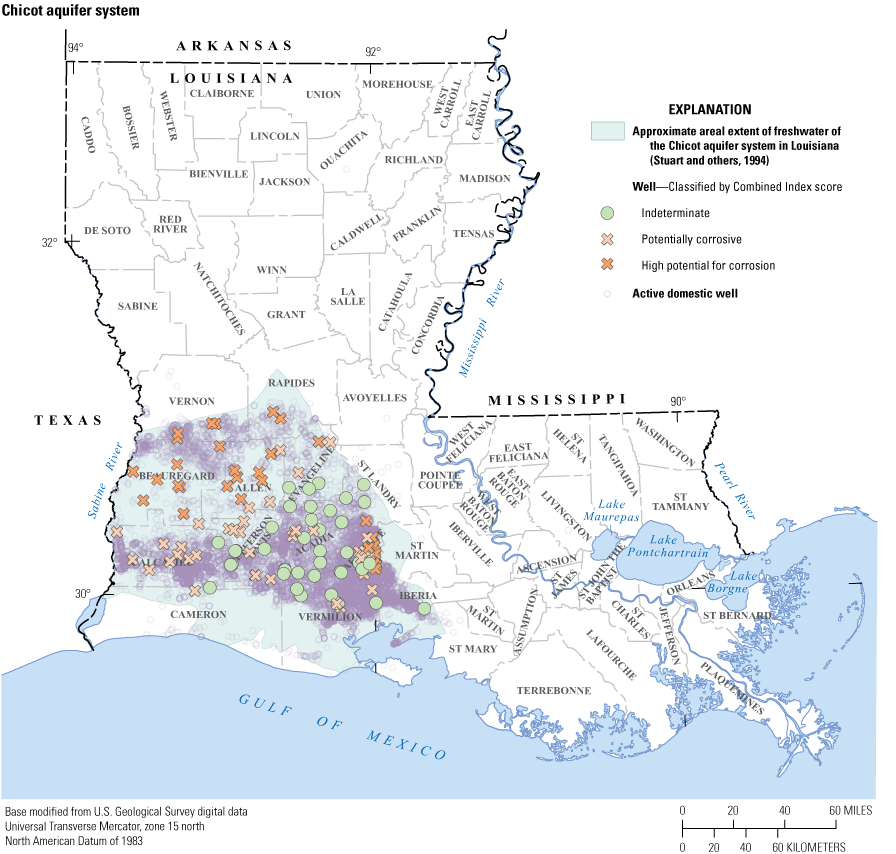
Combined Index classifications for wells used to calculate potential corrosivity of untreated groundwater in the Chicot aquifer system in Louisiana.
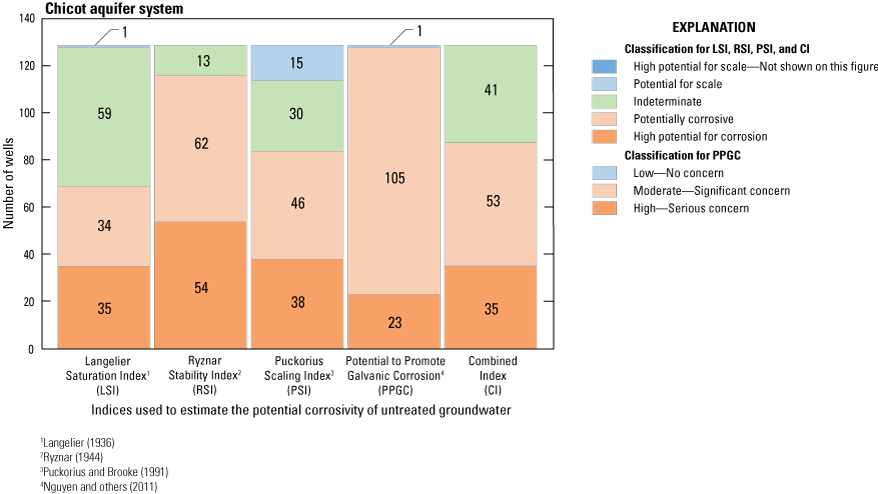
Numbers of wells in each classification of the Langelier Saturation Index, Ryznar Stability Index, Puckorius Stability Index, Potential to Promote Galvanic Corrosion, and Combined Index for calculation of potential corrosivity of groundwater in the Chicot aquifer system in Louisiana.
Table 7.
Average potential corrosivity scores by index by parish for wells screened in the Chicot aquifer system in Louisiana.[LSI, Langelier Saturation Index; RSI, Ryznar Stability Index; PSI, Puckorius Stability Index; PPGC, Potential to Promote Galvanic Corrosion; CI, Combined Index; T, tie]
| Parish (fig. 19) | LSI | RSI | PSI | PPGC | CI |
|---|---|---|---|---|---|
| Acadia | −0.121 | 7.42 | 6.43 | Significant concern | 3.48 |
| Allen | −2.95 | 12.0 | 11.3 | Significant/serious concern (T) | 4.70 |
| Beauregard | −3.51 | 12.9 | 12.1 | Serious concern | 4.97 |
| Calcasieu | −0.484 | 8.38 | 8.04 | Significant concern | 3.91 |
| Cameron | 0.0898 | 7.22 | 6.38 | Significant concern | 3.37 |
| Evangeline | −0.720 | 8.24 | 7.05 | Significant concern | 3.71 |
| Iberia | 0.0576 | 6.88 | 5.51 | Significant concern | 3.00 |
| Jefferson Davis | −0.392 | 7.84 | 6.90 | Significant concern | 3.60 |
| Lafayette | −1.55 | 9.62 | 8.59 | Significant concern | 4.25 |
| Rapides | −4.53 | 14.5 | 13.7 | Serious concern | 5.00 |
| St. Landry | −0.707 | 8.33 | 7.38 | Significant concern | 3.75 |
| Vermilion | −0.110 | 7.47 | 6.52 | Significant concern | 3.48 |
| Vernon | −5.25 | 15.8 | 15.7 | Serious concern | 5.00 |
| Average | −1.29 | 9.30 | 8.41 | Significant concern | 4.03 |
Chicot Equivalent Aquifer System
Data associated with groundwater samples from 22 wells screened in the Chicot equivalent aquifer system were used to calculate the LSI, RSI, PSI, CI, and PPGC scores (figs. 21–22). The average scores for the LSI, RSI, PSI, and CI, respectively, were −1.57, 10.4, 10.1, and 4.36 (table 8). The PPGC classified 17 of the 22 samples (or 77 percent) in this aquifer system as having significant concern for corrosivity (fig. 22). Groundwater samples from wells in the northern portion of the Chicot equivalent aquifer system, in the area known as the Florida Parishes (Nyman and Fayard, 1978), have higher corrosivity potential than the samples from wells in the southern part of the aquifer system (fig. 21, table 8).
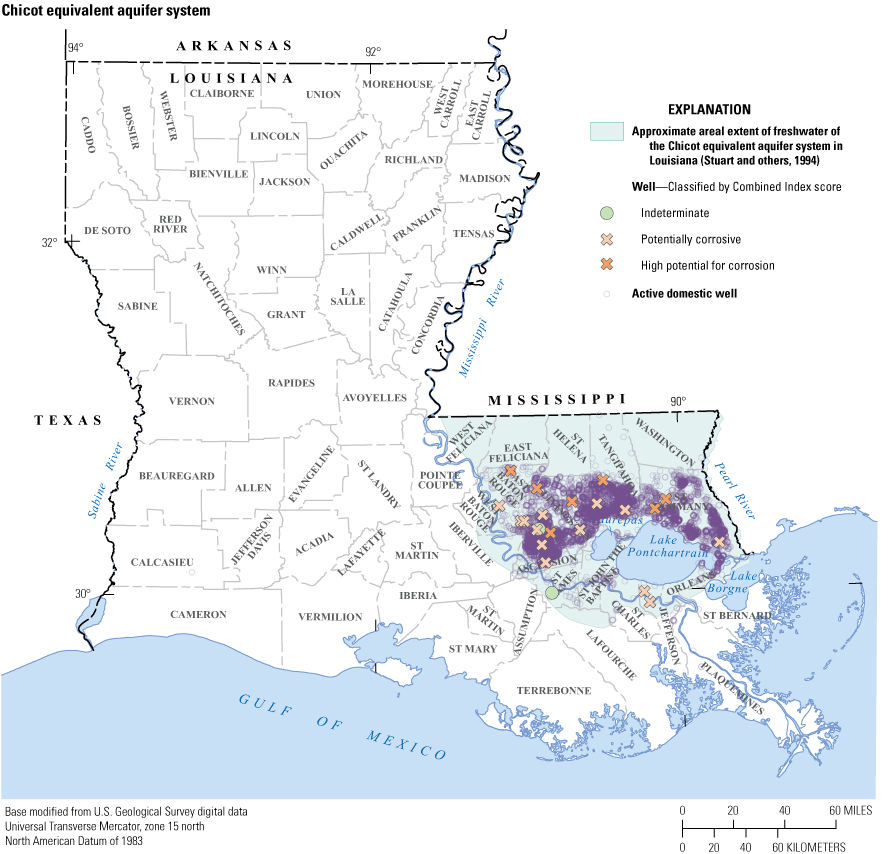
Combined Index classifications for wells used to calculate potential corrosivity of untreated groundwater in the Chicot equivalent aquifer system in Louisiana.

Numbers of wells in each classification of the Langelier Saturation Index, Ryznar Stability Index, Puckorius Stability Index, Potential to Promote Galvanic Corrosion, and Combined Index for calculation of potential corrosivity of groundwater in the Chicot equivalent aquifer system in Louisiana.
Table 8.
Average potential corrosivity scores by index by parish for wells screened in the Chicot equivalent aquifer system in Louisiana.[LSI, Langelier Saturation Index; RSI, Ryznar Stability Index; PSI, Puckorius Stability Index; PPGC, Potential to Promote Galvanic Corrosion; CI, Combined Index]
| Parish (fig. 21) | LSI | RSI | PSI | PPGC | CI |
|---|---|---|---|---|---|
| Ascension | −0.0313 | 8.16 | 8.49 | Significant concern | 3.87 |
| East Baton Rouge | −1.11 | 10.0 | 10.2 | Significant concern | 4.37 |
| Jefferson | −0.420 | 8.99 | 9.12 | Significant concern | 4.13 |
| Livingston | −2.11 | 10.8 | 10.4 | Significant concern | 4.50 |
| St. James | −0.234 | 7.27 | 5.72 | Significant concern | 3.25 |
| St. Tammany | −2.40 | 11.7 | 11.4 | Significant concern | 4.67 |
| Tangipahoa | −3.01 | 12.3 | 11.6 | Significant concern | 4.67 |
| Average | −1.57 | 10.4 | 10.1 | Significant concern | 4.36 |
Evangeline Equivalent Aquifer System
Data associated with groundwater samples from 22 wells screened in the Evangeline equivalent aquifer system were used to calculate the LSI, RSI, PSI, CI, and PPGC scores (figs. 23–24). The average scores for the LSI, RSI, PSI, and CI, respectively, were −0.824, 10.1, 10.9, and 4.27 (table 9). The PPGC classified the samples in this aquifer as having significant concern for corrosivity, with 18 of the 22 samples (or 82 percent) in this class (fig. 24). Samples from wells in East Feliciana Parish had the highest likelihood for potentially corrosive water.
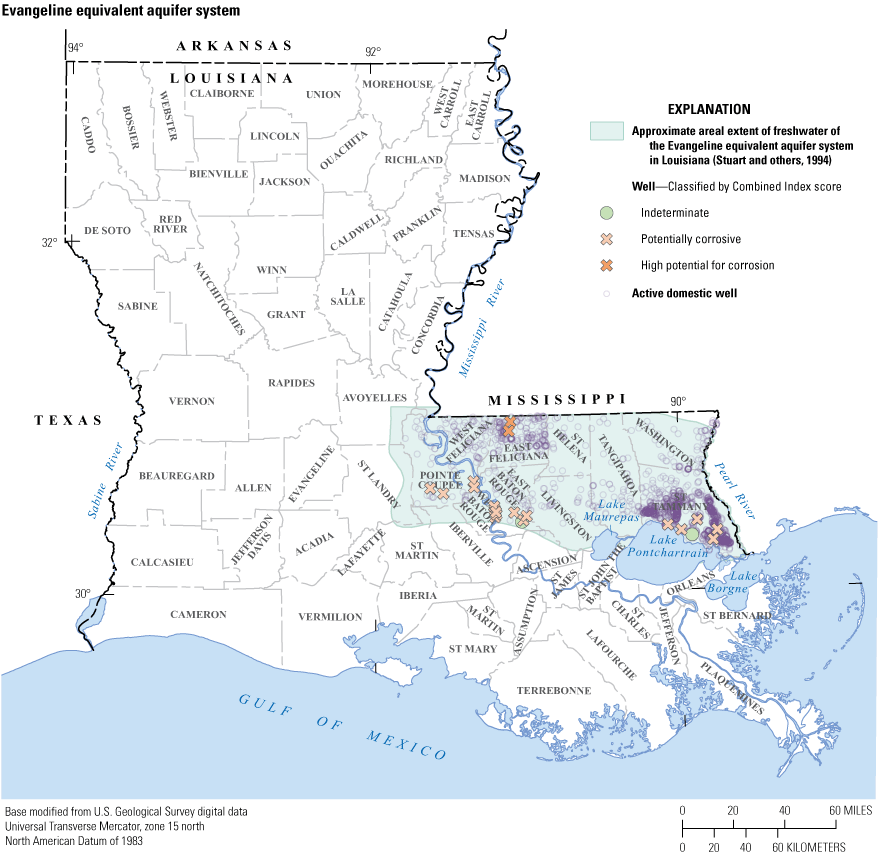
Combined Index classifications for wells used to calculate potential corrosivity of untreated groundwater in the Evangeline equivalent aquifer system in Louisiana.
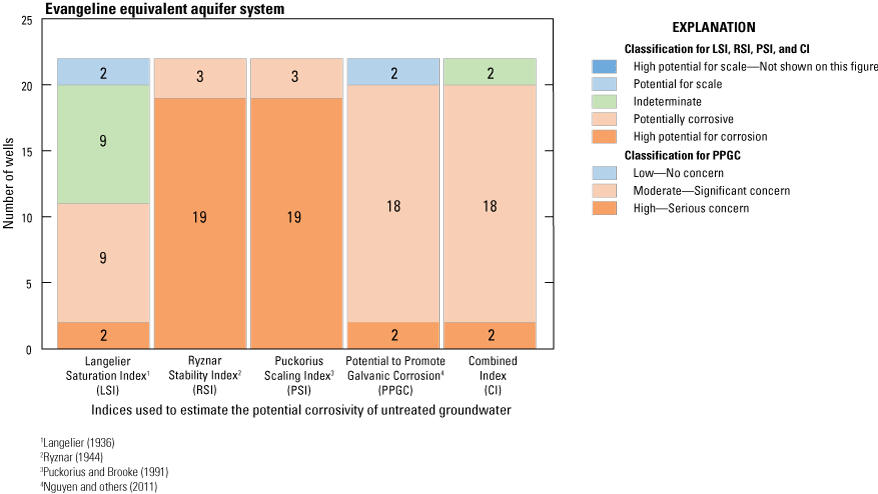
Numbers of wells in each classification of the Langelier Saturation Index, Ryznar Stability Index, Puckorius Stability Index, Potential to Promote Galvanic Corrosion, and Combined Index for calculation of potential corrosivity of groundwater in the Evangeline equivalent aquifer system in Louisiana.
Table 9.
Average potential corrosivity scores by index by parish for wells screened in the Evangeline equivalent aquifer system in Louisiana.[LSI, Langelier Saturation Index; RSI, Ryznar Stability Index; PSI, Puckorius Stability Index; PPGC, Potential to Promote Galvanic Corrosion; CI, Combined Index]
| Parish (fig. 23) | LSI | RSI | PSI | PPGC | CI |
|---|---|---|---|---|---|
| East Baton Rouge | −0.242 | 9.12 | 10.1 | Significant concern | 3.93 |
| East Feliciana | −3.51 | 12.7 | 11.7 | Serious concern | 5.00 |
| Pointe Coupee | −1.04 | 10.5 | 11.3 | Significant concern | 4.42 |
| St. Tammany | −0.197 | 9.29 | 10.2 | Significant concern | 4.06 |
| West Baton Rouge | −0.934 | 10.6 | 11.6 | Significant concern | 4.46 |
| Average | −0.824 | 10.1 | 10.9 | Significant concern | 4.27 |
Jasper Equivalent Aquifer System
Data associated with groundwater samples from 12 wells screened in the Jasper equivalent aquifer system were used to calculate the LSI, RSI, PSI, CI, and PPGC scores (figs. 25–26). The average scores for the LSI, RSI, PSI, and CI, respectively, were −0.761, 10.0, 10.7, and 4.35 (table 10). The PPGC classified all 12 samples in this aquifer system as having significant concern for corrosivity (fig. 26).
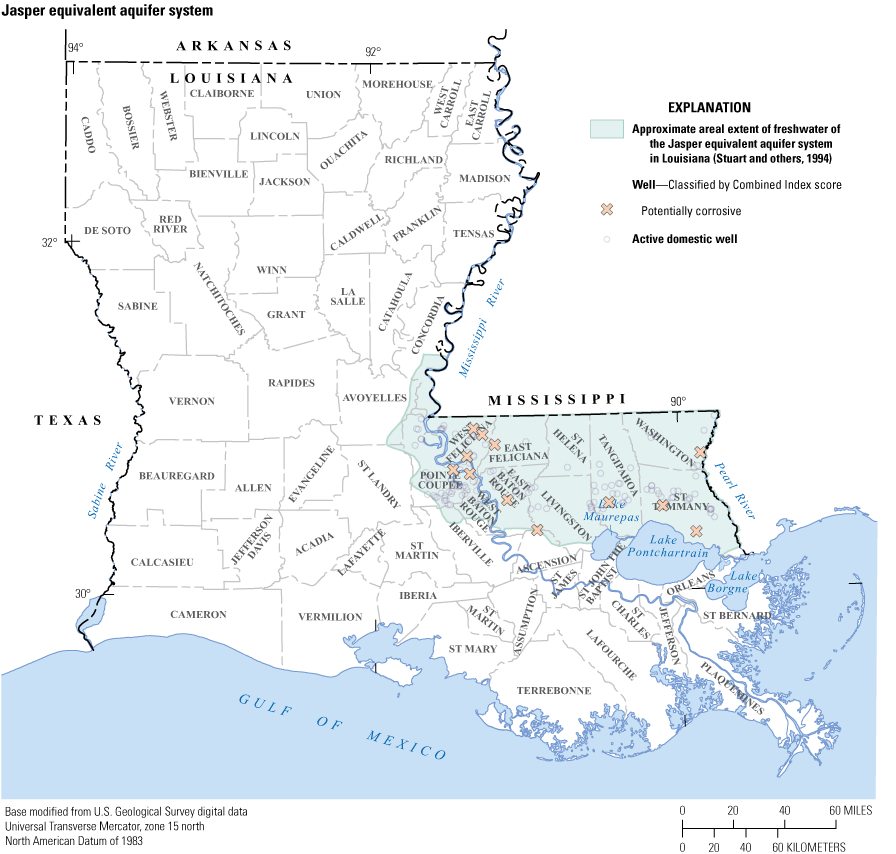
Combined Index classifications for wells used to calculate potential corrosivity of untreated groundwater in the Jasper equivalent aquifer system in Louisiana.
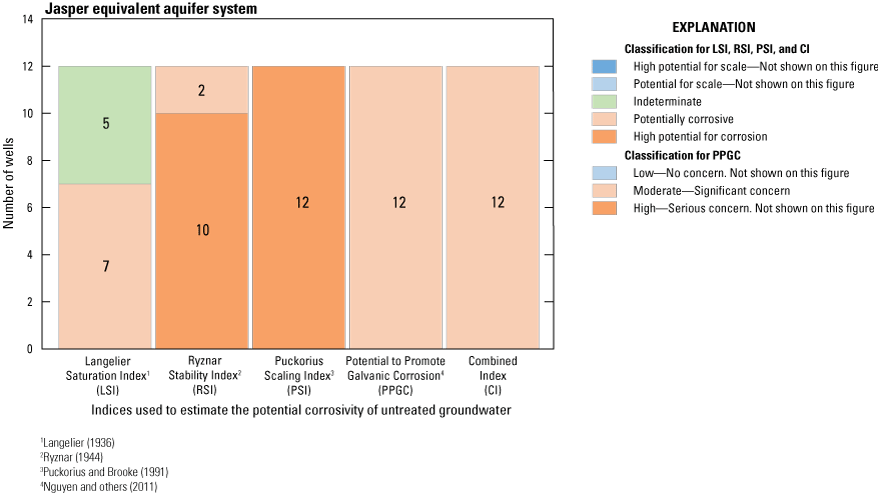
Numbers of wells in each classification of the Langelier Saturation Index, Ryznar Stability Index, Puckorius Stability Index, Potential to Promote Galvanic Corrosion, and Combined Index for calculation of potential corrosivity of groundwater in the Jasper equivalent aquifer system in Louisiana.
Table 10.
Average potential corrosivity scores by index by parish for wells screened in the Jasper equivalent aquifer system in Louisiana.[LSI, Langelier Saturation Index; RSI, Ryznar Stability Index; PSI, Puckorius Stability Index; PPGC, Potential to Promote Galvanic Corrosion; CI, Combined Index]
| Parish (fig. 25) | LSI | RSI | PSI | PPGC | CI |
|---|---|---|---|---|---|
| East Baton Rouge | −0.352 | 9.55 | 10.4 | Significant concern | 4.25 |
| East Feliciana | −0.530 | 9.76 | 10.7 | Significant concern | 4.50 |
| Pointe Coupee | −0.141 | 9.33 | 10.6 | Significant concern | 4.13 |
| St. Tammany | −0.619 | 9.74 | 10.5 | Significant concern | 4.25 |
| Tangipahoa | −1.80 | 11.9 | 12.6 | Significant concern | 4.50 |
| Washington | −1.79 | 11.8 | 12.4 | Significant concern | 4.50 |
| West Feliciana | −0.931 | 9.83 | 10.1 | Significant concern | 4.50 |
| Average | −0.761 | 10.0 | 10.7 | Significant concern | 4.35 |
Sparta Aquifer
Data associated with groundwater samples from 53 wells screened in the Sparta aquifer were used to calculate the LSI, RSI, PSI, CI, and PPGC scores (figs. 27–28). The average scores for the LSI, RSI, PSI, and CI, respectively, were −1.46, 10.5, 10.5, and 4.33 (table 11). The PPGC classified 45 of the 53 samples (or 85 percent) as having significant concern for corrosivity (fig. 28).
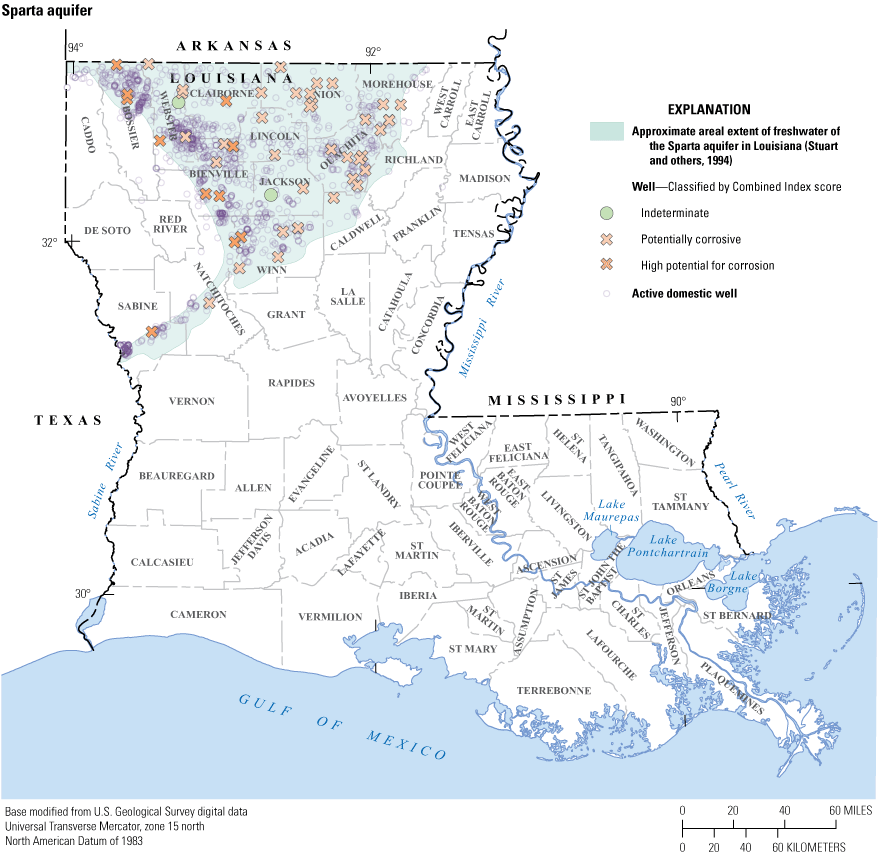
Combined Index classifications for wells used to calculate potential corrosivity of untreated groundwater in the Sparta aquifer in Louisiana.

Numbers of wells in each classification of the Langelier Saturation Index, Ryznar Stability Index, Puckorius Stability Index, Potential to Promote Galvanic Corrosion, and Combined Index for calculation of potential corrosivity of groundwater in the Sparta aquifer in Louisiana.
Table 11.
Average potential corrosivity scores by index by parish for wells screened in the Sparta aquifer in Louisiana.[LSI, Langelier Saturation Index; RSI, Ryznar Stability Index; PSI, Puckorius Stability Index; PPGC, Potential to Promote Galvanic Corrosion; CI, Combined Index; T, tie]
| Parish (fig. 27) | LSI | RSI | PSI | PPGC | CI |
|---|---|---|---|---|---|
| Bienville | −3.54 | 13.0 | 12.5 | Significant concern | 4.58 |
| Bossier | −4.78 | 14.9 | 14.2 | Serious concern | 4.92 |
| Caldwell | −0.608 | 9.72 | 9.65 | Significant concern | 4.37 |
| Claiborne | −1.74 | 11.4 | 11.7 | Significant concern | 4.63 |
| Jackson | −0.187 | 8.57 | 8.72 | Significant concern | 3.88 |
| Lincoln | −1.23 | 10.6 | 10.9 | Significant concern | 4.50 |
| Morehouse | −0.0856 | 8.52 | 8.54 | Significant concern | 3.87 |
| Natchitoches | −2.94 | 12.9 | 13.1 | Significant/serious concern (T) | 4.63 |
| Ouachita | −0.333 | 9.17 | 9.47 | Significant concern | 4.14 |
| Sabine | −5.03 | 15.1 | 14.1 | Serious concern | 5.00 |
| Union | −0.650 | 9.59 | 9.91 | Significant concern | 4.21 |
| Webster | −1.07 | 9.43 | 9.23 | Significant concern | 4.16 |
| Winn | −1.33 | 10.5 | 10.4 | Significant concern | 4.46 |
| Average | −1.46 | 10.5 | 10.5 | Significant concern | 4.33 |
Carrizo-Wilcox Aquifer
Data associated with groundwater samples from 82 wells screened in the Carrizo-Wilcox aquifer were used to calculate the LSI, RSI, PSI, and CI scores, and data associated with groundwater samples from 81 wells were used to calculate the PPGC score (figs. 29–30). The average scores for the indices, respectively, were −0.822, 9.26, 8.90, and 4.07, all indicating potentially corrosive groundwater (table 12). The PPGC classified the samples in this aquifer as having significant concern for corrosivity, with 74 out of the 81 samples (or 91 percent) in this class (fig. 30).
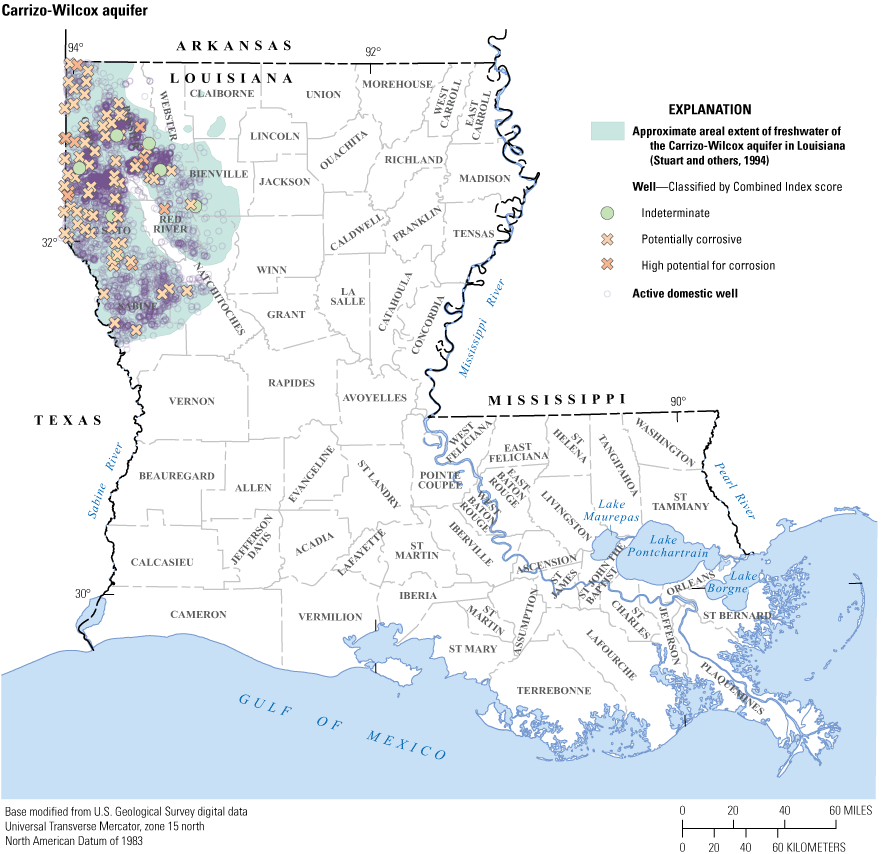
Combined Index classifications for wells used to calculate potential corrosivity of untreated groundwater in the Carrizo-Wilcox aquifer in Louisiana.
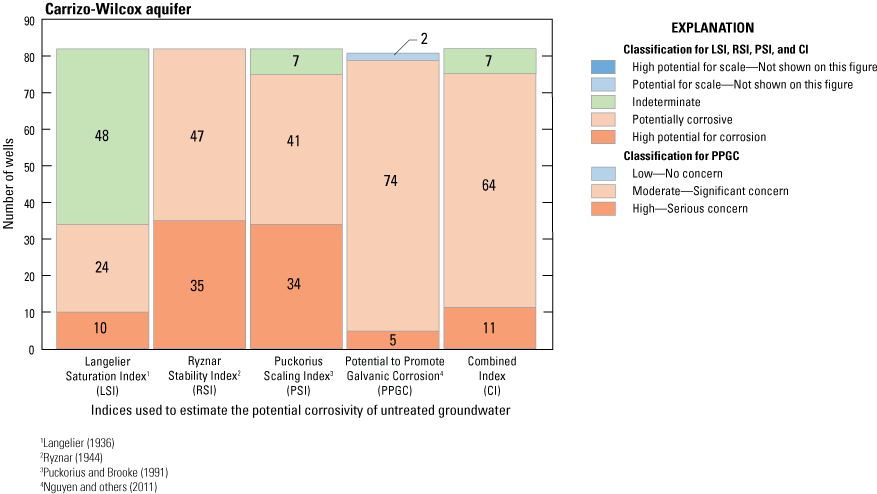
Numbers of wells in each classification of the Langelier Saturation Index, Ryznar Stability Index, Puckorius Stability Index, Potential to Promote Galvanic Corrosion, and Combined Index for calculation of potential corrosivity of groundwater in the Carrizo-Wilcox aquifer in Louisiana.
Table 12.
Average potential corrosivity scores by index by parish for wells screened in the Carrizo-Wilcox aquifer in Louisiana.[LSI, Langelier Saturation Index; RSI, Ryznar Stability Index; PSI, Puckorius Stability Index; PPGC, Potential to Promote Galvanic Corrosion; CI, Combined Index]
| Parish (fig. 29) | LSI | RSI | PSI | PPGC | CI |
|---|---|---|---|---|---|
| Bienville | −0.457 | 8.65 | 8.21 | Significant concern | 4.00 |
| Bossier | −0.749 | 9.05 | 8.57 | Significant concern | 3.95 |
| Caddo | −1.11 | 9.62 | 9.25 | Significant concern | 4.17 |
| DeSoto | −0.607 | 9.01 | 8.72 | Significant concern | 4.04 |
| Natchitoches | −0.0991 | 8.80 | 8.92 | Significant concern | 4.00 |
| Red River | −2.49 | 11.1 | 9.68 | Significant concern | 4.75 |
| Sabine | −0.277 | 8.96 | 8.87 | Significant concern | 3.97 |
| Average | −0.822 | 9.26 | 8.90 | Significant concern | 4.07 |
Aquifers and Aquifer Systems With Insufficient Data
Fifteen wells were screened in the 5 remaining aquifers and aquifer systems that had at least 1 adequate water-quality record but in total did not have the minimum number of samples per aquifer for calculation of individual LSI, RSI, PSI, CI, and PPGC scores for each of those aquifers or aquifer systems; therefore, the scores for these samples, as a group, were calculated (figs. 31–32) (table 13).
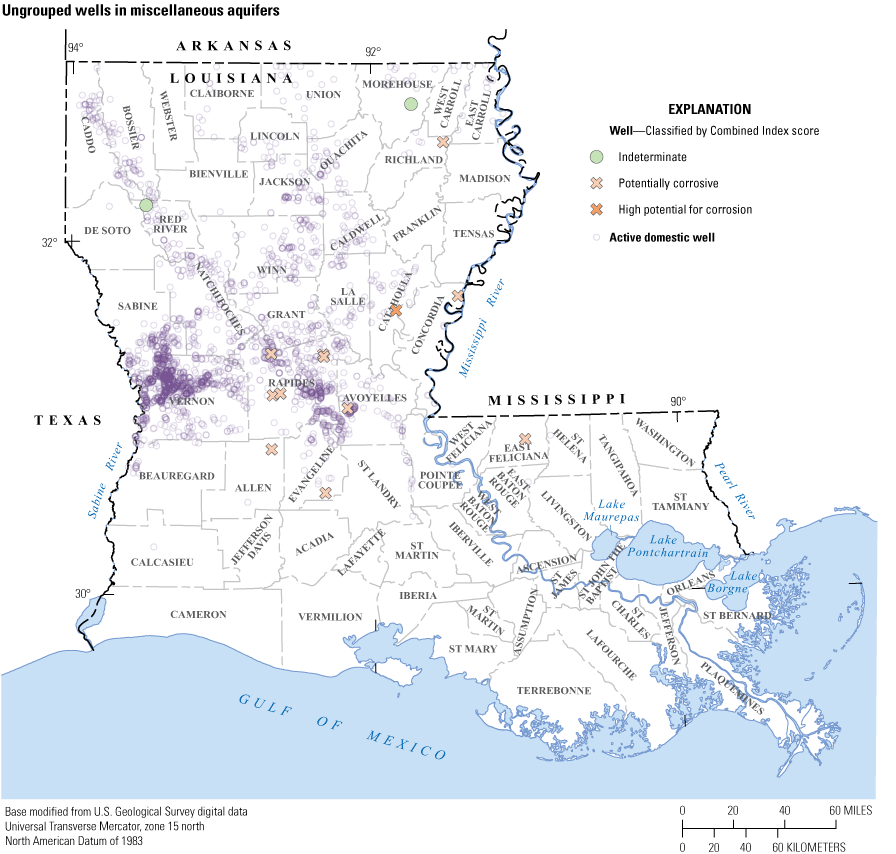
Combined Index classifications for wells used to calculate potential corrosivity of untreated groundwater in aquifers with insufficient water-quality data for individual classification in Louisiana.
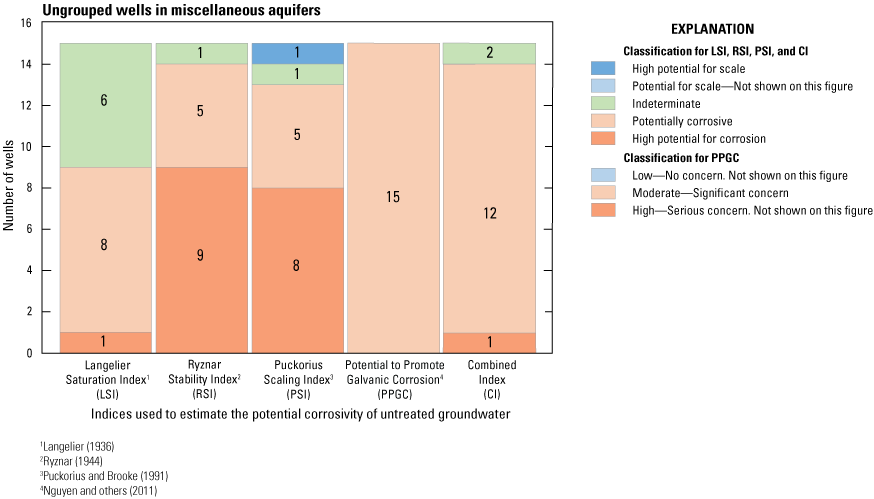
Numbers of wells in each classification of the Langelier Saturation Index, Ryznar Stability Index, Puckorius Stability Index, Potential to Promote Galvanic Corrosion, and Combined Index for calculation of potential corrosivity of groundwater in aquifers with insufficient water-quality data for individual classification in Louisiana.
Table 13.
Average potential corrosivity scores by index by parish for wells in ungrouped aquifers in Louisiana.[LSI, Langelier Saturation Index; RSI, Ryznar Stability Index; PSI, Puckorius Stability Index; PPGC, Potential to Promote Galvanic Corrosion; CI, Combined Index]
| Parish (fig. 31) | LSI | RSI | PSI | PPGC | CI |
|---|---|---|---|---|---|
| Allen | −0.799 | 10.4 | 11.5 | Significant concern | 4.50 |
| Avoyelles | 0.267 | 8.37 | 9.02 | Significant concern | 4.00 |
| Catahoula | −3.35 | 13.4 | 12.5 | Significant concern | 4.75 |
| Concordia | −1.67 | 11.1 | 10.7 | Significant concern | 4.50 |
| East Feliciana | −0.343 | 9.39 | 10.1 | Significant concern | 4.25 |
| Evangeline | −0.717 | 8.73 | 7.75 | Significant concern | 4.00 |
| Morehouse | −0.0846 | 7.27 | 6.17 | Significant concern | 3.50 |
| Rapides | −0.978 | 9.87 | 9.83 | Significant concern | 4.29 |
| Red River | 0.161 | 6.58 | 4.93 | Significant concern | 2.75 |
| Richland | −0.241 | 7.98 | 7.23 | Significant concern | 3.75 |
| Average | −0.843 | 9.49 | 9.26 | Significant concern | 4.12 |
Summary and Conclusions
Corrosive groundwater itself is not dangerous, but it has the potential to react with and release metals from pipes and plumbing in water distribution systems. These metals, if ingested, could cause serious health implications; therefore, the corrosivity potential of groundwater in Louisiana has been estimated at a statewide scale by the U.S. Geological Survey, in cooperation with the Louisiana Department of Transportation and Development, by using water-quality data from about 375 untreated groundwater samples from wells. Four existing indices—the Langelier Saturation Index (LSI), Ryznar Stability Index (RSI), Puckorius Scaling Index (PSI), and the Potential to Promote Galvanic Corrosion (PPGC)—and an analysis which normalized the results from the existing indices, the Combined Index (CI), were used to assess the corrosivity of groundwater in Louisiana for eight major aquifers and aquifer systems and ungrouped wells screened in miscellaneous aquifers.
The percentages of samples classified as potentially corrosive, by index, are as follows: LSI, 53 percent; RSI, 94 percent; PSI, 81 percent; PPGC, 98 percent; and CI, 81 percent. The percentages of samples classified as indeterminate, by index, are as follows: LSI, 46 percent; RSI, 5 percent; PSI, 12 percent; and CI, 18 percent.
Even with the discrepancies among the indices, a few commonalities are evident. All five indices indicate that, of the aquifers or aquifer systems with sufficient data for analysis, the upland terrace aquifer has the highest potential for corrosive groundwater and the Mississippi River alluvial aquifer has the least potential for corrosive groundwater. Additionally, the area known as the Florida Parishes, in southeastern Louisiana, north of Lake Pontchartrain, has consistently high scores, indicating potentially corrosive groundwater in that area’s aquifers. Vernon, Rapides, Beauregard, Allen, and Evangeline Parishes also have consistently high scores. Both aforementioned areas have high concentrations of domestic wells that often provide untreated groundwater for rural-domestic purposes.
Acknowledgments
Special thanks are given to USGS employees Jill Jenkins, John Lovelace, Melissa Harris, Paul Frederick, and Jim Kingsbury.
References Cited
Belitz, K., Jurgens, B.C., and Johnson, T.D., 2016a, Potential corrosivity of untreated groundwater in the United States: U.S. Geological Survey Scientific Investigations Report 2016–5092, 16 p., accessed September 19, 2019, at https://pubs.er.usgs.gov/publication/sir20165092.
Belitz, K., Jurgens, B.C., and Johnson, T.D., 2016b, Classification of chloride-to-sulfate mass ratio for U.S. groundwater with respect to the potential to promote galvanic corrosion of lead, 1991–2015; Water well data and characteristic values for States: U.S. Geological Survey data release, accessed March 6, 2020, at https://doi.org/10.5066/F7MC8X40.
Belitz, K., Jurgens, B.C., Johnson, T.D., 2016c, Langelier Saturation Indices computed for U.S. groundwater, 1991–2015; Water well data and characteristic values for States: U.S. Geological Survey data release, accessed March 6, 2020, at https://doi.org/10.5066/F7XW4GWX.
Collier, A.L., and Sargent, B.P., 2018, Water use in Louisiana, 2015: Louisiana Department of Transportation and Development Water Resources Special Report no. 18, 138 p. [Also available at https://wise.er.usgs.gov/dp/pdfs/WaterUseinLouisiana_2015.pdf.]
Leitz, F., and Guerra, K., 2013, Water chemistry analysis for water conveyance, storage and desalination projects—Manuals and Standards Program: Denver, Colo., U.S. Department of the Interior, Bureau of Reclamation, Technical Service Center, 14 p., accessed February 11, 2020, at https://www.usbr.gov/tsc/techreferences/mands/mands-pdfs/WQeval_documentation.pdf.
Louisiana Department of Health, 2020, Community preparedness and health protection—Safe Drinking Water Program, accessed January 16, 2020, at https://ldh.la.gov/index.cfm/page/963.
Louisiana Department of Natural Resources, 2020, SONRIS (Strategic Online Natural Resources Information System), accessed October 30, 2020, at https://www.sonris.com/.
Louisiana Section of the American Society of Civil Engineers, 2017, Report card for Louisiana infrastructure, 2017: American Society of Civil Engineers, accessed March 7, 2019, at https://www.infrastructurereportcard.org/wp-content/uploads/2016/10/Lousiana-FullReport-LA_2017.pdf.
McGee, B.D., and Brantly, J.A., 2015, Potentiometric surface, 2012, and water-level differences, 2005–12, of the Sparta aquifer in north-central Louisiana: U.S. Geological Survey Scientific Investigations Map 3313, 2 sheets, accessed November 3, 2019 at https://doi.org/10.3133/sim3313.
Nguyen, C.K., Stone, K.R., and Edwards, M.A., 2011, Chloride-to-sulfate mass ratio—Practical studies in galvanic corrosion of lead solder: Journal of the American Water Works Association, v. 103, no. 1, p. 81–92. accessed March 12, 2020, at https://doi.org/10.1002/j.1551-8833.2011.tb11384.x.
Puckorius, P.R., and Brooke, J.M., 1991, A new practical index for calcium carbonate scale prediction in cooling tower systems: Corrosion, v. 47, no. 4, p. 280–284, accessed March 12, 2020, at https://doi.org/10.5006/1.3585256.
Roberge, P.R., 2007, Appendix B of Corrosion inspection and monitoring: New York, John Wiley & Sons, 4 p. [Also available at https://onlinelibrary.wiley.com/doi/abs/10.1002/9780470099766.app2.]
Robinson, A.L., 2024, Potential corrosivity scores of untreated groundwater in Louisiana: U.S. Geological Survey data release, https://doi.org/10.5066/P9MFM8J1.
Ryals, G.N., 1984, Regional geohydrology of the northern Louisiana salt-dome basin; Part II, Geohydrologic maps of the Tertiary aquifers and related confining layers: U.S. Geological Survey Water-Resources Investigations Report 83–4135, 6 p., 7 pls. [Also available at https://pubs.er.usgs.gov/publication/wri834135.]
Ryznar, J.W., 1944, A new index for determining amount of calcium carbonate scale formed by a water: Journal of the American Water Works Association, v. 36, no. 4, p. 472–483. [Also available at https://doi.org/10.1002/j.1551-8833.1944.tb20016.x.]
Swistock, B.R., Clemens, S., and Sharpe, W.E., 2009, Drinking water quality in rural Pennsylvania and the effect of management practices: Harrisburg, Pa., The Center for Rural Pennsylvania, 24 p. [Also available at http://www.rural.palegislature.us/drinking_water_quality.pdf.]
U.S. Census Bureau, 2016, Annual estimates of the resident population—April 1, 2010 to July 1, 2015, accessed March 9, 2017, at https://factfinder.census.gov/bkmk/table/1.0/en/PEP/2015/PEPANNRES/0400000US22|0400000US22.05000.
U.S. Environmental Protection Agency, 2016, Basic information about lead in drinking water, accessed August 2, 2018, at https://www.epa.gov/your-drinking-water/basic-information-about-lead-drinking-water.
U.S. Geological Survey, 2006, Collection of Water Samples (ver. 2.0): U.S. Geological Survey Techniques of Water-Resources Investigations, book 9, chap. A4, accessed March 9, 2022, at http://pubs.water.usgs.gov/twri9A.
U.S. Geological Survey, 2016, USGS Water Data for the Nation: U.S. Geological Survey National Water Information System database, accessed April 21, 2020, at https://doi.org/10.5066/F7P55KJN.
Appendix 1. Other Indices
Conversion Factors
Temperature in degrees Celsius (°C) may be converted to degrees Fahrenheit (°F) as follows: °F = (1.8 × °C) + 32.
Temperature in degrees Fahrenheit (°F) may be converted to degrees Celsius (°C) as follows: °C = (°F – 32) / 1.8.
Supplemental Information
Specific conductance is given in microsiemens per centimeter at 25 degrees Celsius (µS/cm at 25 °C).
Concentrations of chemical constituents in water are given in milligrams per liter (mg/L).
Because of rounding, totals and percentages presented in the tables, figures, and text in the report may differ slightly from totals or percentages calculated individually.
For more information about this publication, contact
Director, Lower Mississippi-Gulf Water Science Center
U.S. Geological Survey
640 Grassmere Park, Suite 100
Nashville, TN 37211
For additional information, visit
https://www.usgs.gov/centers/lmg-water/
Publishing support provided by
Lafayette Publishing Service Center
Disclaimers
Any use of trade, firm, or product names is for descriptive purposes only and does not imply endorsement by the U.S. Government.
Although this information product, for the most part, is in the public domain, it also may contain copyrighted materials as noted in the text. Permission to reproduce copyrighted items must be secured from the copyright owner.
Suggested Citation
Robinson, A.L., 2024, Potential corrosivity of untreated groundwater in Louisiana: U.S. Geological Survey Scientific Investigations Report 2024–5035, 52 p., https://doi.org/10.3133/sir20245035.
ISSN: 2328-0328 (online)
Study Area
| Publication type | Report |
|---|---|
| Publication Subtype | USGS Numbered Series |
| Title | Potential corrosivity of untreated groundwater in Louisiana |
| Series title | Scientific Investigations Report |
| Series number | 2024-5035 |
| DOI | 10.3133/sir20245035 |
| Publication Date | November 06, 2024 |
| Year Published | 2024 |
| Language | English |
| Publisher | U.S. Geological Survey |
| Publisher location | Reston, VA |
| Contributing office(s) | Lower Mississippi-Gulf Water Science Center |
| Description | Report: viii, 52 p.; Appendix; 2 Data Releases |
| Country | United States |
| State | Louisiana |
| Online Only (Y/N) | Y |


